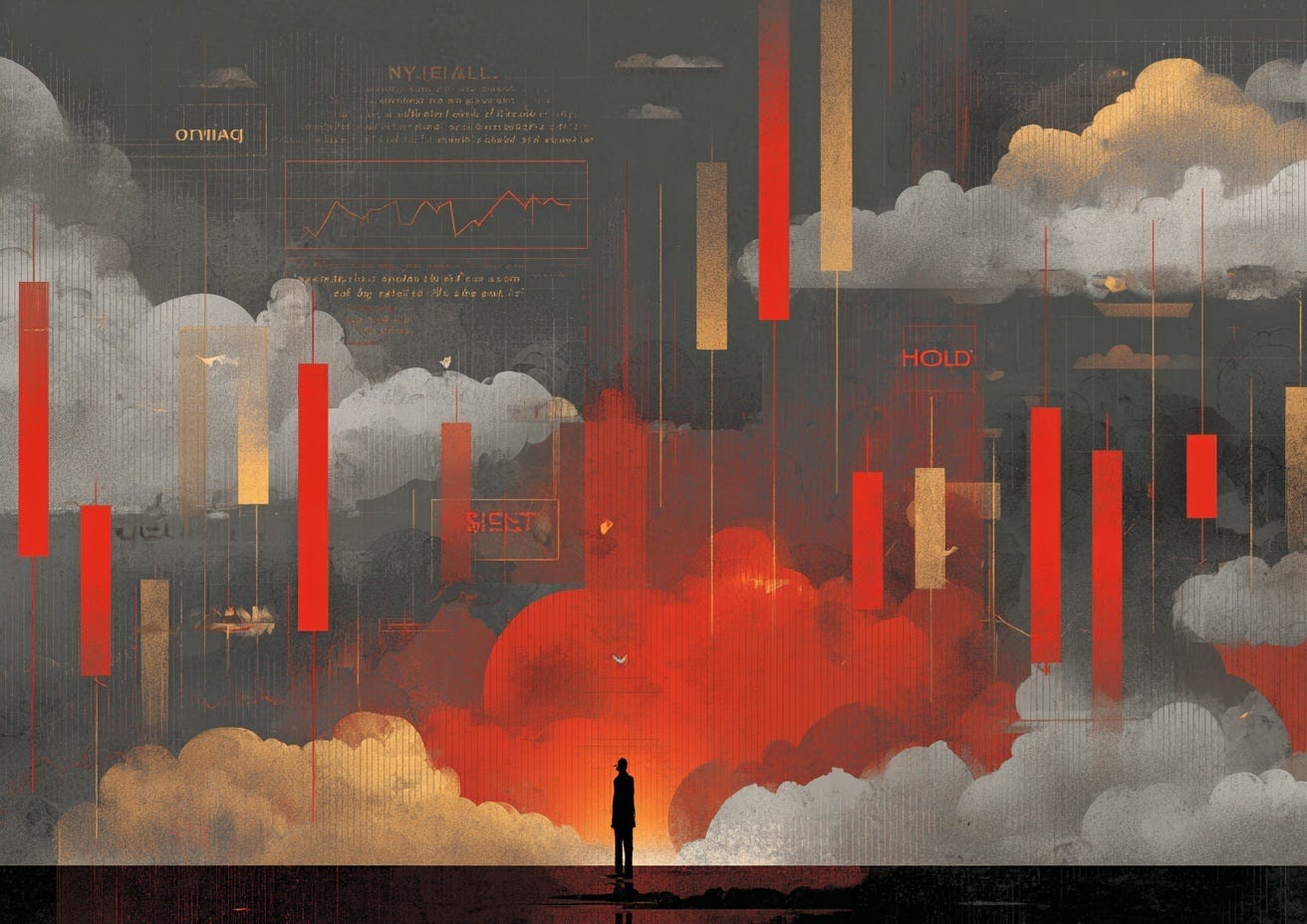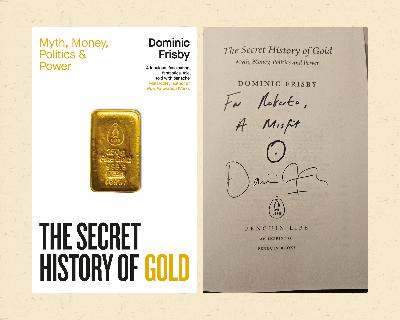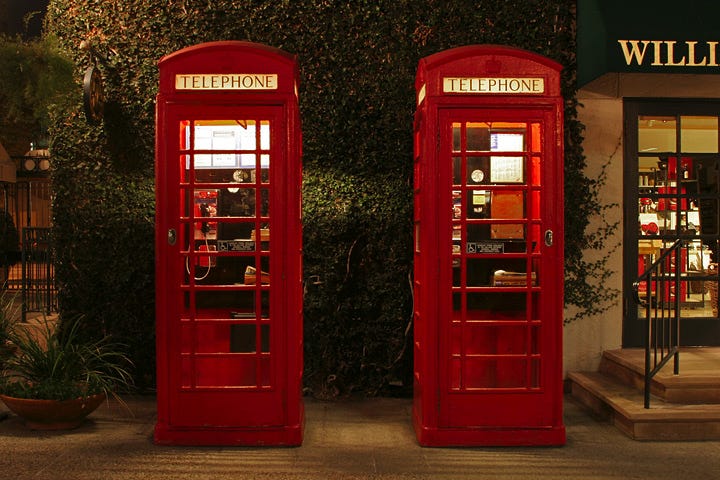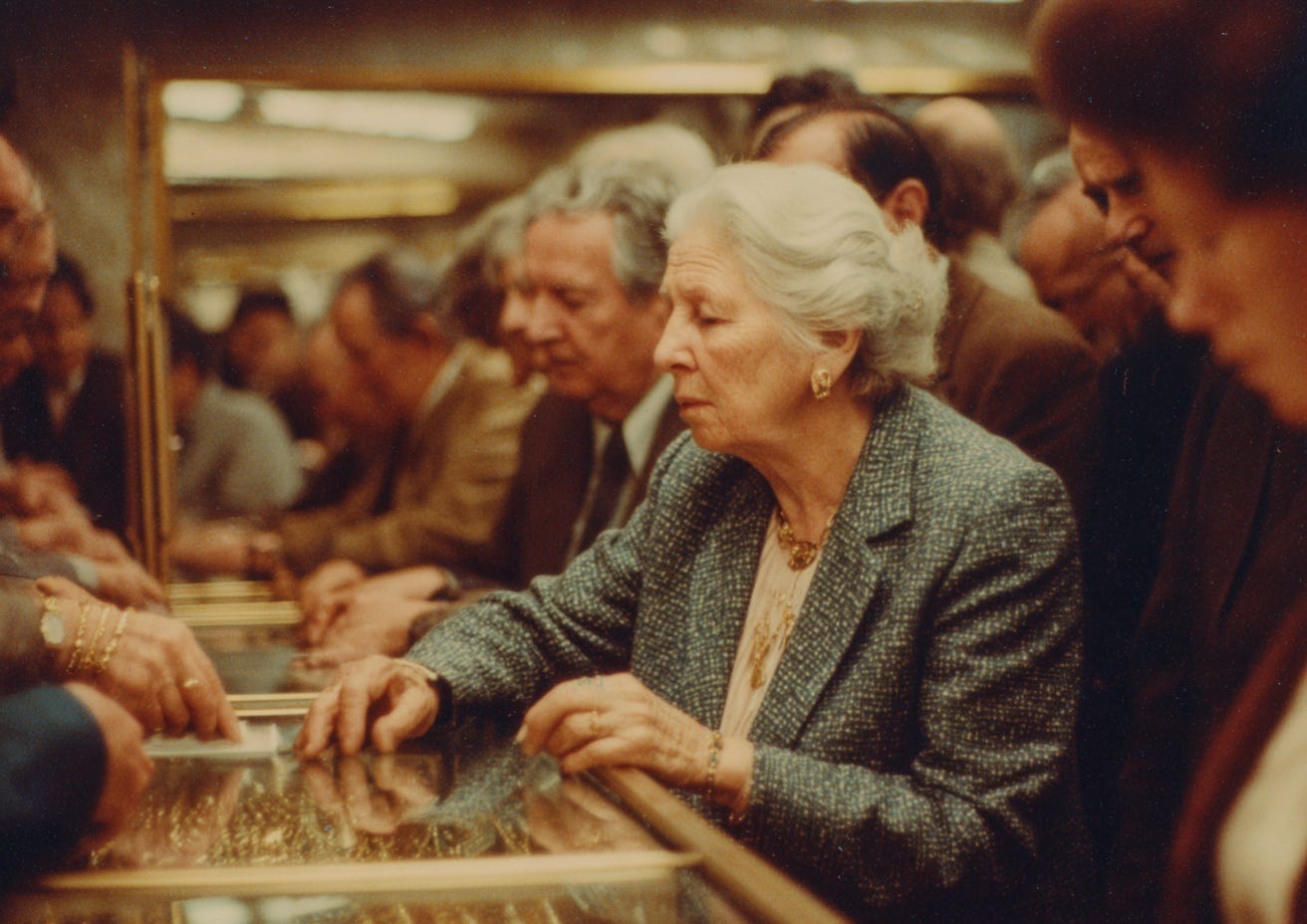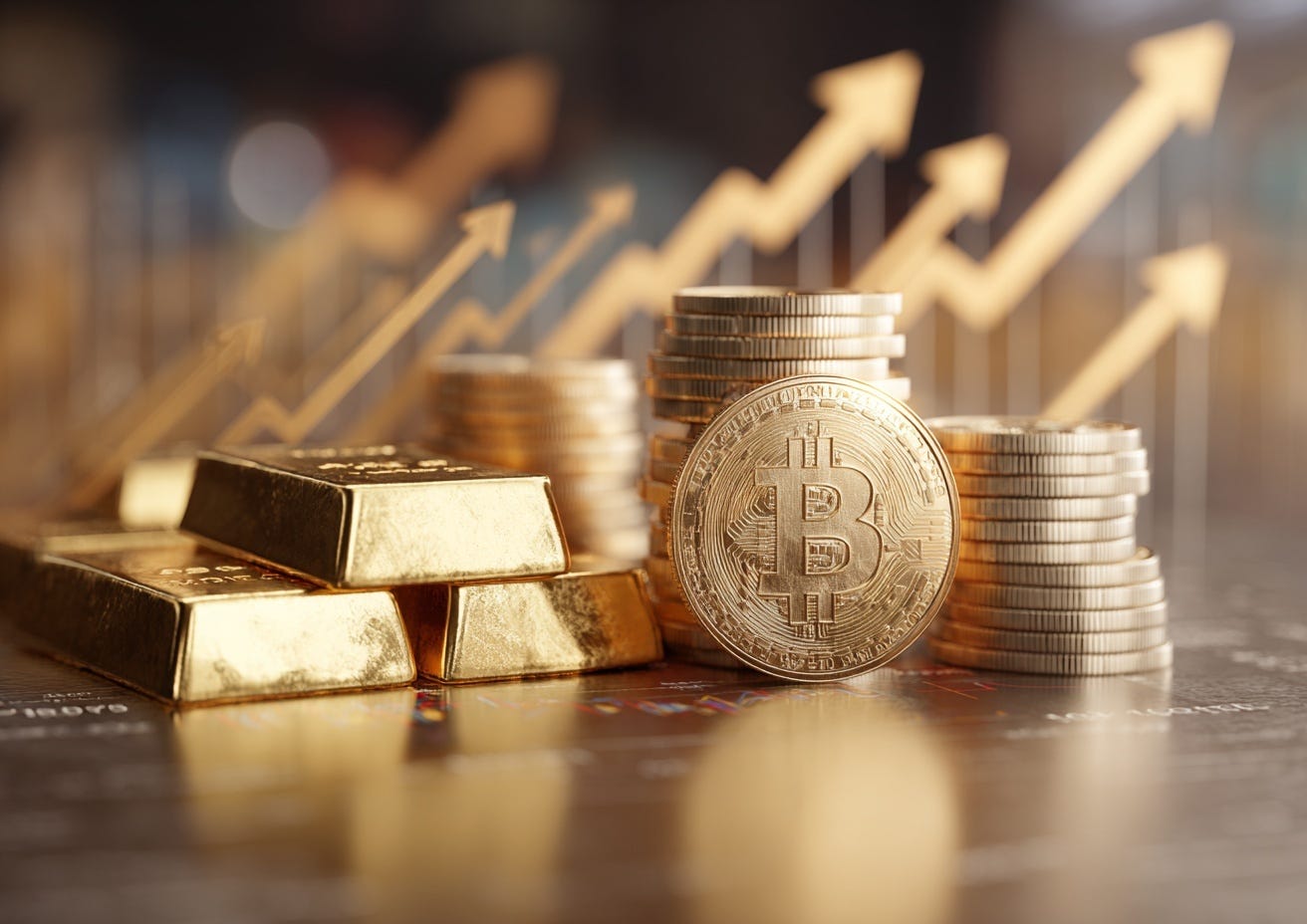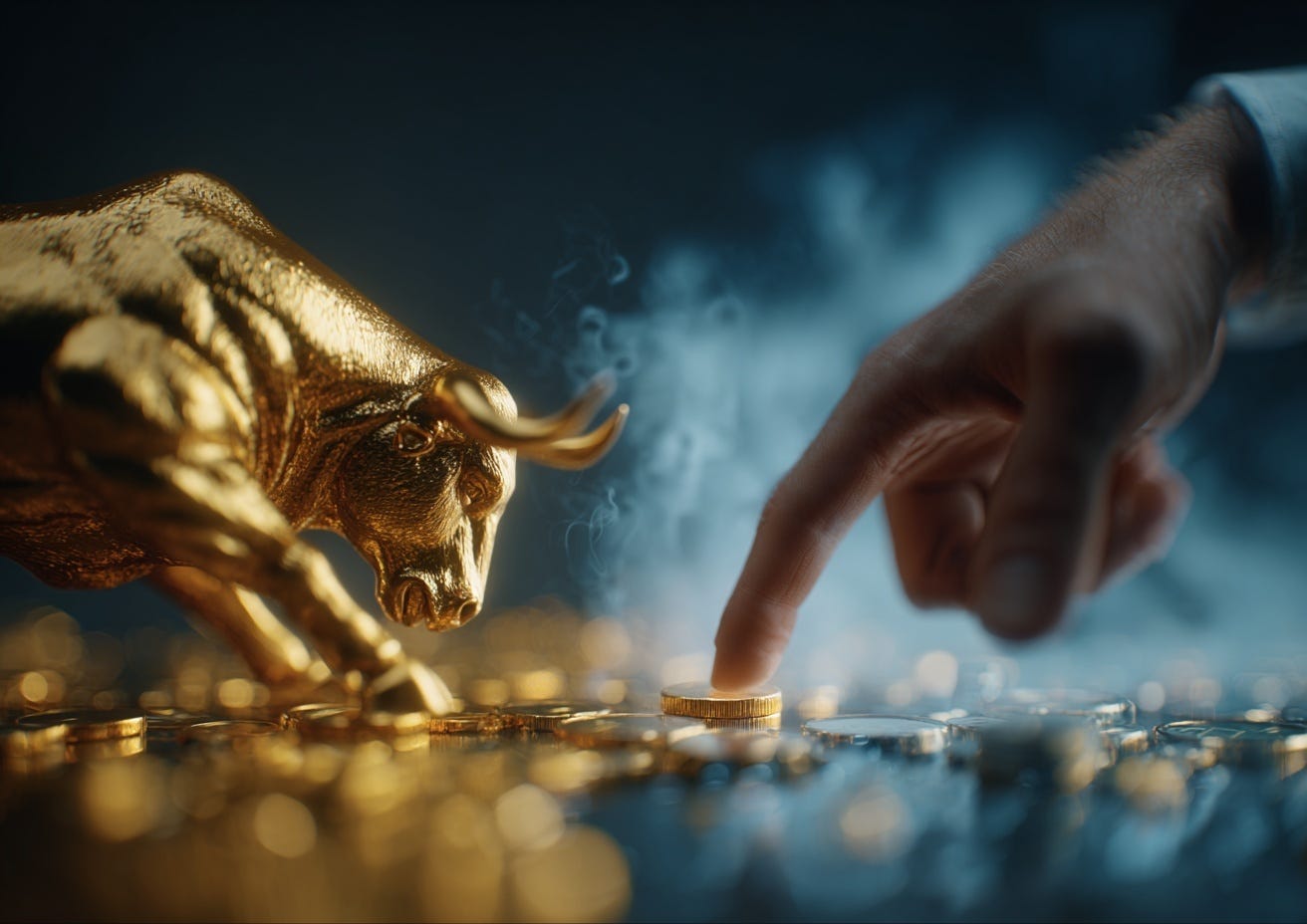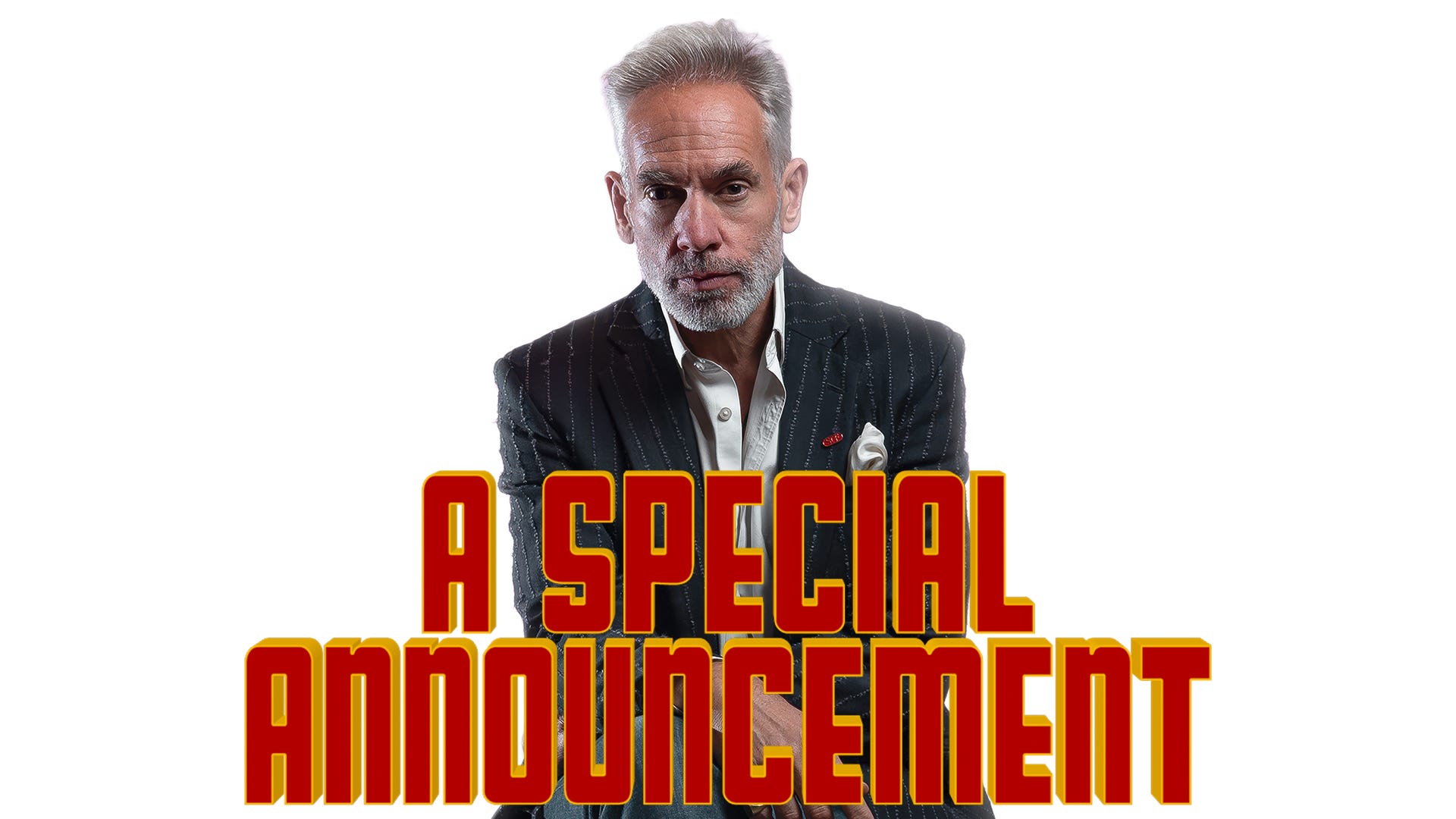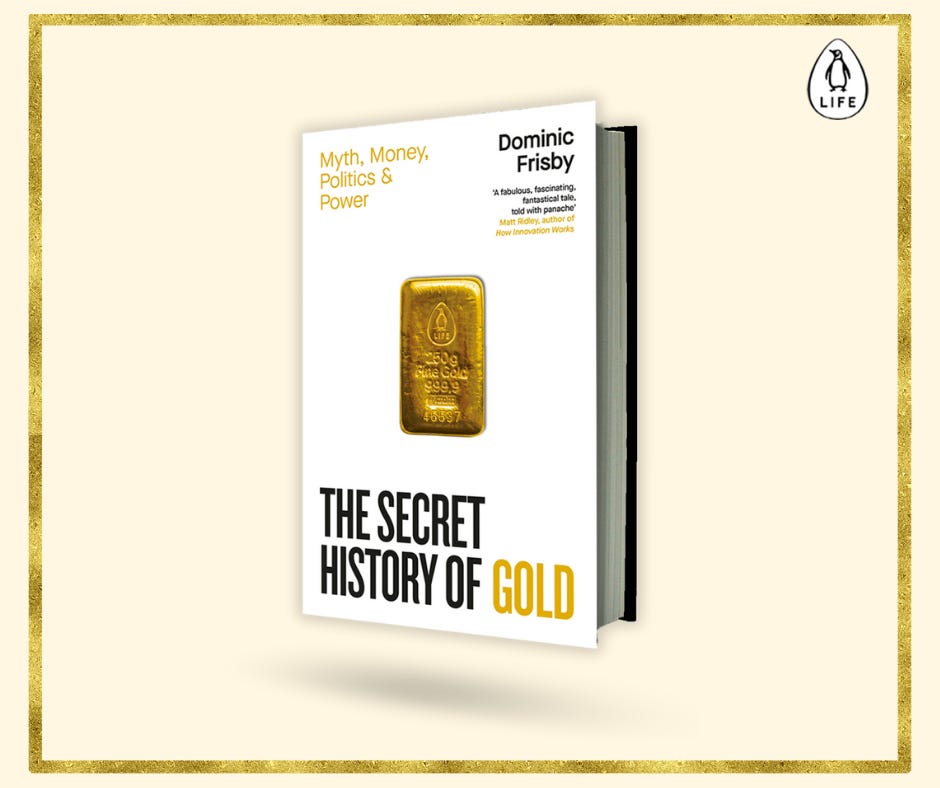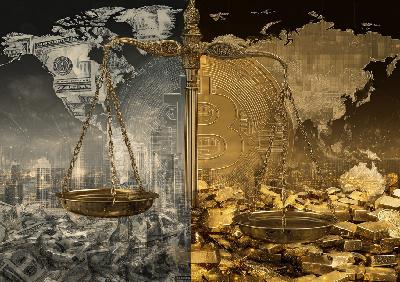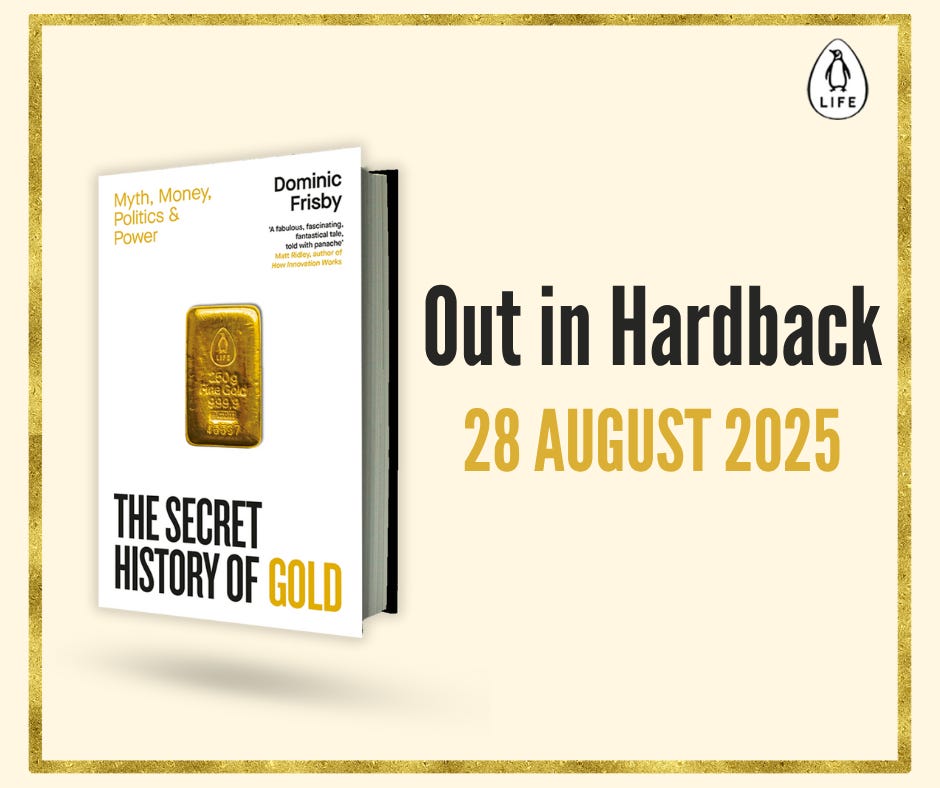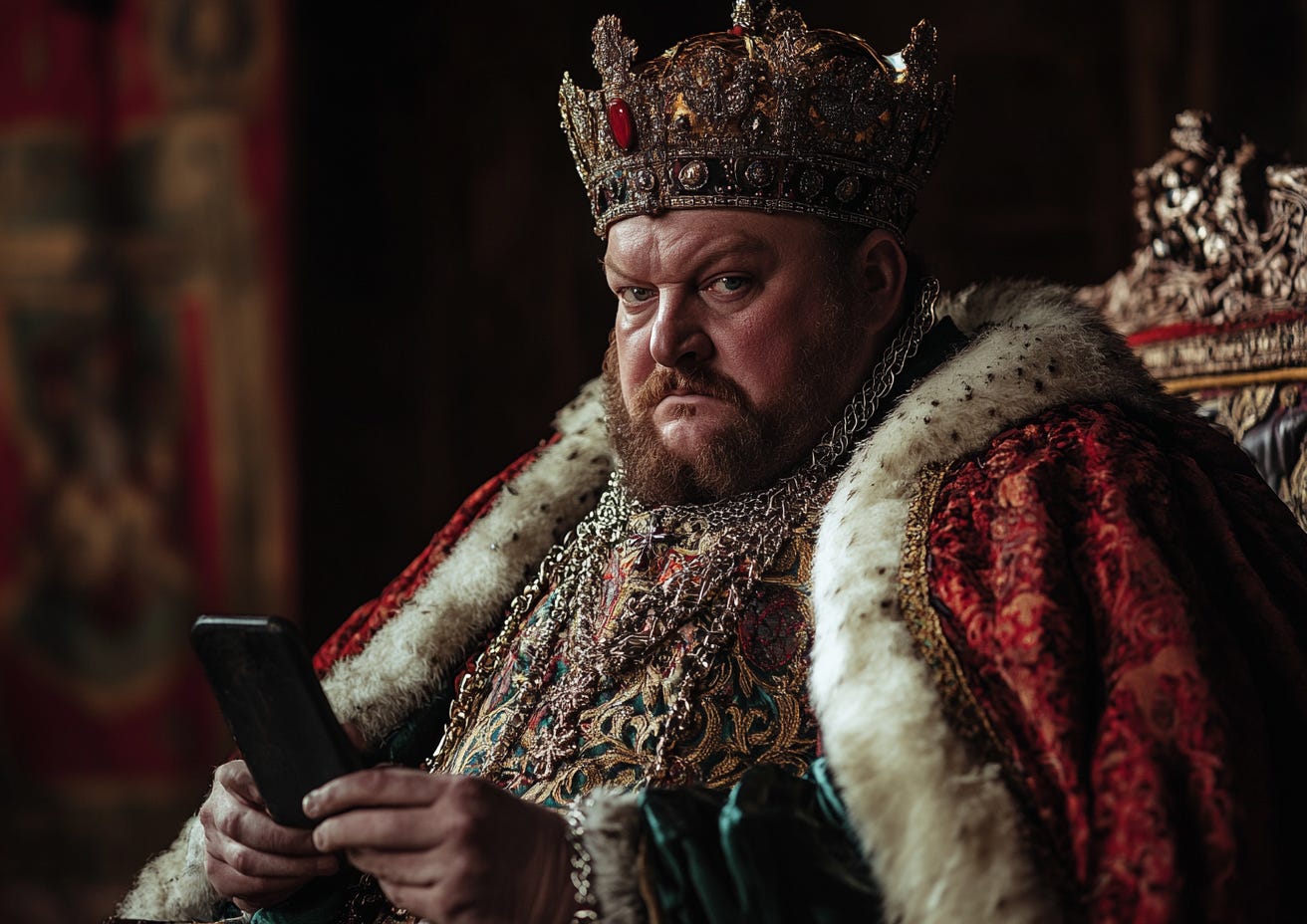Discover The Flying Frisby - money, markets and more
The Flying Frisby - money, markets and more

The Flying Frisby - money, markets and more
Author: Dominic Frisby
Subscribed: 145Played: 7,112Subscribe
Share
© Dominic Frisby
Description
Readings of brilliant articles from the Flying Frisby. Occasional super-fascinating interviews. Market commentary, investment ideas, alternative health, some social commentary and more, all with a massive libertarian bias.
www.theflyingfrisby.com
www.theflyingfrisby.com
576 Episodes
Reverse
This is a free preview of a paid episode. To hear more, visit www.theflyingfrisby.comI don’t mean to get all bearish on you.Bearish copy - it’s all going down, it’s going to crash - gets more eyeballs than “everything’s fine”. Bearish commentators usually have bigger followings. Bad news sells.But bears are usually wrong. They’ve predicted 13 of the last two corrections.The fact is, as human beings progress and economies grow, markets tend to rise. This is doubly so when the underlying unit of account - the pound, the euro, the dollar - is being systematically debased. (Which makes the underperformance of the FTSE these last 25 years even more incredible by the way). Stock markets, especially in the US, have become places to park capital, where you can reduce erosion by inflation.So that’s my disclaimer out of the way.I’m feeling bearishWe’ll start with bitcoin. It’s a leading indicator for the Nasdaq and tech. It’s sold off - from $125,000 in early October to $90,000 a coin on Monday. Remember: I targeted $90,000 a coin a few weeks back.The crypto summer was muted, so we can expect this crypto winter to be similarly muted - no 90% corrections in other words. But we are almost 30% down already.Strip out the noise and HODL is my advice. That’s what I’m doing. There has been no better investment strategy over the last 15 years and I’m sticking with it. But a crypto winter is upon us, it seems. Let’s hope it’s a mild one.Here’s the chart. Look at the 50 day moving average in red. This is the third time in since 2024 that we have been in this situation.One correction lasted most of 2024 - well, March to October - the other took up the first five months of this year. They passed.Also worth noting is how each correction seems to have three spikes down - three drives to the bottom. This time around we have only had one, so maybe a couple more to go. That is not a prediction by the way: just an observation.The corrections in gold and silver have been more muted. But I have to say the silver chart concerns me. Double top or what?I thought the October correction would go deeper than it did, but it held up at the 50 day moving average (red line). That’s a sign of strength. This rebound rally, dead cat bounce - whatever you want to call it - has taken us right back to the old highs, while gold and the S&P500 both made lower highs. That is also a sign of relative strength.But the second high was not confirmed by the silver miners, that is not good. And now we have a double top on our hands, until we don’t.I would think we have one more leg down to get through plus some sideways consolidation to digest the gains of earlier this year. Here is gold, FYI, which has conspicuously made a lower high. This one might want to go into the $3 thousands for a bit.The stock market has this ridiculous Nvidia situation to get through. $4.4 trillion market cap - and that’s after the recent pullback. 40 stocks account for something like 60% of the market cap of the five hundred stocks in the S&P. It needs to rebalance, otherwise it’s an index of 40 stocks with 460 hangers-on. Corrections are how these things happen.So I am feeling über cautious. There is nothing wrong with having cash in times like this - it means you can buy stuff.On the other hand, the year end rally is approaching - so maybe we should just stay long. As with bitcoin, the way to play the stock market since 2009 when the S&P500 reached 666 - it is ten times that today! - has been simply to hold on through. With so many conflicting messages, it’s hard to know what to do. Dolce Far Niente … Italian for HODL.With all that in mind, I want to just skim through some of my speculative positions and give you my latest opinion on them. we are going to look at Metals Exploration (MTL.L), Comstock (LODE.NYSE), Lightbridge (LTBR), Minera Alamos (MAI.V) and more. Time to sell? Time to buy more?Let’s see. A review of the speculative portfolioWe’ll start with Metals Exploration (MTL.L), my largest position.
Good Sunday to you,As your thought piece this week, we have my interview with Kitco News, talking gold, tax, deficits and more with Jeremy Szafron. I’ve ripped the audio so that those who listen to the podcast can hear it as well.These signed copies of Secret History of Gold have proved quite popular, so I have ordered another box. (They make good Christmas presents). If you would like one, please email me - frizzers at gmail.com. Note: they are cheaper via Amazon (via me I have to charge you postage) but you don’t get my signature or a message. Finally, ICYMI is this week’s commentary, in which we check in on the Dolce Far Niente portfolio.Until next time,Dominic I urge you to own gold or silver, especially if you live in the Third World Country such as the UK. The bullion dealer I recommend is The Pure Gold Company. Pricing is competitive, quality of service is high. They deliver to the UK, the US, Canada and Europe or you can store your gold with them. More here. This is a public episode. If you'd like to discuss this with other subscribers or get access to bonus episodes, visit www.theflyingfrisby.com/subscribe
This is a free preview of a paid episode. To hear more, visit www.theflyingfrisby.comI’ve been writing so much about gold and silver lately, I need to cover something else.But my quick take: as seemed likely, gold and silver have gone into one of their corrective phases. This is likely to last several months, in the humble opinion of this writer. There’ll be false dawns, which catch everyone out, and false deaths too, with the overall trend being sideways.In the event of a broader stock market correction - which is long overdue given the scale of this rally since the Tariff Tantrum™ in the spring - gold and, especially, silver will sell off along with everything else. That doesn’t mean gold isn’t a safe haven. It just means there is a lot of hot money in gold, which quickly gets liquidated in a sell-off.But, yes, this incredible rally we have seen in the S&P500 since the Tariff Tantrum™ is looking exhausted and seems to be rolling over.Bitcoin is taking a hit too - although not as big a hit as the broader crypto space - and bitcoin is what I want to look at today.Here is one crypto trader’s desk, as pictured on Twitter during Tuesday’s sell-off.That’s what happens when you use too much leverage.What do they say about taking the emotion out of trading?Bitcoin - what gives?So many things have happened this year which have blown winds in bitcoin’s favour* A newly elected US administration which very pro crypto* A deliberately weaker dollar and the debasement trade* The launch of the bitcoin ETFs in the US increasing access to much larger flows of capital* Strength in tech stocks generally* A risk-on appetite* The halving cycleAnd moreYet bitcoin feels like it hasn’t quite delivered. A new high of ‘only’ $125,000.The latest narrative doing the rounds is this idea that the launch of the bitcoin ETFs is like bitcoin’s IPO. Just as when a big tech stock IPOs, a lot of early seed money takes the opportunity to exit, so are many early bitcoin investors - so-called OGs - now moving on. That would explain the many coins that have been moved from previously dormant wallets to exchanges over the last six months.Maybe.What can I say?You can either decide that bitcoin’s time is done. It’s game over. Move on.Or you can treat this like another of the numerous shake-outs that have taken bitcoin in the 16 years since its inception. The story was getting a bit tired. It needs a shake-out to ruffle a few feathers and purge.The moral of every previous correction can be summed up in 4 letters: HODL.It looks like we may have got a bit of a crypto winter to get through. If the winter reflects the previous summer, then this one shouldn’t be too bad. But consolidation phases can be frustrating, so the secret is to be quite zen about the whole thing and keep your eye on the bigger picture.Bitcoin bear markets can be painful, but the beauty of them is that, unlike mining bear markets which can go on for a decade or more, they tend to be short lived.Treat bear markets as opportunities. They’re a good time to build positions, build businesses and more. Go and watch some Michael Saylor videos and re-indoctrinate yourself.But on no account lose your position. Bull markets come along when you least expect them.Everything is looking a bit red at the moment - gold, silver, the S&P500, bitcoin. It might be the end of this cycle. but it’s not the end of the world.I don’t know when or where this bitcoin correction ends. My guess is around $90,000 but that’s nothing more than a guess. Perhaps we revisit $75,000 - which is the level we hit during the Tariff Tantrum™ earlier this year.But it’s just as possible that dip below $100k on Tuesday was a fake-out, and the bear market is already done.I thought this graphic was interesting.There is plenty more room for future buying as governments and corporations try to increase their positions.By the way I get that some readers like bitcoin and others don’t. That’s fine. Each to their own. However, if you are in the latter camp, you do not need to email me and tell me bitcoin is not real money/quantum computing is going to destroy it/it is an invention of the deep state/ it is a scam. Please also feel no need to regurgitate Peter Schiff tweets either. (I’m fairly sure he is paid to slag bitcoin off by the way).Turning now to the clusterfook that is the UKBuying bitcoin ETFs in the UK - t he hows, whats and whysIt’s semantics, but you can’t actually buy ETFs in the UK you have to buy ETNs. I’m not even going to bother trying to explain it. It’s regulatory bollocks and not worth wasting time or brain power over.October 8th, the date when the FCA decided UK citizens are allowed to buy bitcoin ETNs is now behind us, but the farce is not.I first found out about bitcoin in December 2010 when it was 22c. I was sent my first coins soon after. I wrote the first book on bitcoin from a recognised publisher in 2014. Yet this morning I just attempted to complete the FCA’s form to get me approved to buy a bitcoin ETN - so that I understand the risks - and I failed it. The “correct” answer to their questions is actually the wrong answer. Absolute farce of an organisation and accountable to no one, so it will continue.In the US, meanwhile, JP Morgan is in the process of enabling bitcoin to be used as mortgage collateral.It’s like being in Spain in 1492, the ship is setting sail to the New World and somebody from the FCA is standing on the gangplank with a clipboard stopping UK citizens from getting onboard.Amongst the plethora of moronic barriers which the FCA has laid down is that bitcoin carries the same risk as any other cryptocurrency - including the latest meme, scam or shitcoin. Bitcoin is not fartcoin, and categorising the two together reveals the scary depths of FCA ignorance.Meanwhile, from next year you won’t be able to buy bitcoin ETNs in your ISA, you will have to get a special ISA. They are trying to kill us with bureaucracy, I’m convinced of it.Which broker and which ETN?In terms of enabling their customers to invest, the UK brokers have ranged from excellent - Interactive Investor, which went live on day 1, as boss Richard Wilson proudly tells me - to totally useless - Hargreaves Lansdown and AJ Bellend.Hargreaves Lansdown, apparently trying to give the FCA a run for its brainless money, even put out the following statement.“Bitcoin is not an asset class, and we do not think cryptocurrency has characteristics that mean it should be included in portfolios for growth or income and shouldn’t be relied upon to help clients meet their financial goals … Unlike other alternative asset classes, it has no intrinsic value.”Talk about retarded.If you want to be able to invest in these things via your SIPP or ISA, move your account to Interactive Investor is my advice. Use this affiliate link and you get a year for free.I should stress buying bitcoin via a broker negates many of bitcoin’s uses. Yes, you get the store-of-value benefits, but you can’t send and receive it; you can’t use it to make payments or donations; you don’t have sovereignty - the fund manager does - and so there is considerable counter-party risk - the coins could be confiscated, the fund could go bust etc. You don’t have anonymity either.Still it’s better than no exposure at all.But which ETN should you go for? And what about the treasury companies? And, what indeed about Semler Scientific (SMLR)?
Good Sunday to you,I am headed to Birmingham and Huddersfield week after next. If you are in either neck of the woods, come and see the show.Don’t it always seem to go That you don’t know what you’ve got ‘til it’s goneJoni MitchellBack in the 1980s I remember the newly privatised British Telecom, in its wisdom, decided to get rid of Britain’s red telephone boxes and replace them with things made of glass or was it perspex? The originals were designed, I’ve since read, by one Giles Gilbert Scott, who got the gig as a result of a design competition. (I’ve since learned he also designed Battersea Power Station, so he was quality).British Telecom wanted a rebranding, so somebody at HQ decided to waste lord-knows-how-much money getting rid of however many phone boxes there were around the country - they’re cast iron so this was not an easy job, nor a cheap one - and replace them with something better, which inevitably turned out to be worse.Here’s the iconic before:Here’s what they replaced them with:I barely remember these. You probably don’t either. Because they were soon got rid of and replaced with these. Why did they bother?The glass replacements are just so bland you cannot not even describe them as ugly. They are just characterless nothings. Why people in corporations feel this need to glassify everything - it’s happened to buildings as well, of course - is beyond me. I guess they think it’s “dynamic”. (Indeed, they’ve done something similar to language).BT justified the rebranding by saying existing phone boxes got vandalised: prostitutes and mini cab drivers left their calling cards in them, people pissed in them. All of this is true, but there were other ways of dealing with these issues. (It’s not unlike the many invented problems being cited today to justify hoisting digital ID on us). The bottom line is that the powers that be wanted a rebrand. Good for their egos, I guess. And thanks to the privatisation they now had bucket loads of capital to spend on it.Whatever. They spent a shedload and made it worse. So there I was walking along Parliament Square the other day and what did I see but a this huge queue of tourists lining up to have their photo taken by a phone box. Not one of the glass ones obviously. And I mean huge queue. See for yourself.I would say there are 40 or more people in that queue. If they each take 45 seconds for their photo, that’s a good 30-minute wait.The rest of the world loves the English for who we are. For our history, our culture, our style, our character, our charm, our order, our beauty. That’s why so many tourists flock here. Why are we incapable of appreciating ourselves and loving what we have created? - instead choosing to self-hate and apologise for what we have done.The rest of the world wants the England of red phone boxes, afternoon tea, good manners and Downton Abbey. They don’t want England for its diversity (diversity is not London’s greatest strength, despite what they mayor may tell you - London’s greatest strength is that it is the capital of England, not Diversityland), nor for its gender-neutral toilets, glass fronted buildings, low trust communities or its street crime. They want England for the English.So the point of today’s missive.A few years ago somebody got the no-doubt-very-well-paid gig erecting cycle sheds around the capital. Here was an opportunity to design something iconic, something which added to London - like the old red buses, black taxis, post boxes and, yes, the phone boxes. Things that characterise London, and thus things that people love London for. Here’s what we got. They even put a picture of a bicycle on the side, just in case you’re totally moronic.Talk about a wasted opportunity.They look like budget Anderson shelters.And what’s the shelf life of one of those. Ten years, maybe?Can you see tourists seventy or eighty years from now queuing up for half an hour to get their photo taken next to one?Oh well.If you enjoyed reading this, please share it far and wide.Lots of things to share with you this week* Here ICYMI is this week’s commentary:* Here is a piece from my comedy Substack about Prunella Scales, who died on Monday. It also contains an episode of a 1975 sitcom you’ve probably never heard of but in which she was absolutely brilliant. I urge you to watch it - you will thank me.* I made an appearance on Jeremy McKeown’s new podcast, along with Tim Price, to talk gold.If you live in a Third World country, such as the UK, I urge you to own gold or silver. The bullion dealer I recommend is The Pure Gold Company. Pricing is competitive, quality of service is high. They deliver to the UK, the US, Canada and Europe or you can store your gold with them. More here.* And, finally, on Friday morning at 07.34 GMT, I became a grandad. Please welcome Cecilia (name not yet confirmed) to the group.As we are headed into Christmas present season, if you are unable to follow the tradition of the Wise Men and gift actual gold, how about a book about gold instead?I deal for anyone at home or at work. The Secret History of Gold - Money, Myth, Politics and Power is available at all good bookstoresUntil next time,Dominic This is a public episode. If you'd like to discuss this with other subscribers or get access to bonus episodes, visit www.theflyingfrisby.com/subscribe
You probably saw my post from ten days ago in which I argued that the vast numbers of people queuing up outside bullion stores in Singapore and Sydney to buy gold and silver were not a good sign.As it turns out, they were not. Gold and silver have put in a top - an interim, mid-cycle top, in my view, not the top - and we can now expect many months of sideways, shake-out, frustrating consolidation to generally piss everyone off. It’s important, in such times, to keep your eye on the bigger picture, which in this case is the inevitable debasement of currency, so as not to lose your position.You’ll know, I’m sure, the story of Joe Kennedy’s shoe shine boy. In 1929, so the story goes, the boy who was polishing the celebrated investor’s shoes started giving him stock tips. If the shoe shine boy has bought in, thought Joe Kennedy Snr, who else is left to buy? That persuaded him that the top was close and he famously sold just before the crash.That story is often cited to illustrate the idea that retail investors are sheep. They’re stupid. You should do the opposite to what retail is doing and so on.I don’t think it’s anything like that simple.There are some retail investors who are stupid. There are plenty who are rookies and naive. But there are plenty who are thoughtful, wise and, as a result, very good investors. By the same token, I have met many fund managers, analysts and more from respected institutions who are thick as pigshite. (I have met plenty of geniuses too). Give me the choice between some blogger and an institutional research report, you’ll often get far more insight from the former. I frequently read bulletin boards, or chats on Twitter, as part of my research into a company.It wasn’t institutions who got into bitcoin early, it was retail. Even now many institutions shun it, particularly in bureaucratic banana republics such as the UK. Who were the smart guys? The people that bought earliest. Retail.Obviously, if you start getting investment tips from a shoe shine boy/taxi driver/barber (my Albanian barber is forever shilling me shitcoins) or your nan’s carer’s mate, that is usually a bad sign, but it doesn’t mean that ordinary folk are stupid.With the above in mind, I stumbled across this video from another legend of American investing, Jim Simons. At the time of his death in 2024, the hedge fund manager’s net worth was north of $30 billion, making him the 55th-richest person in the world.He describes January 21, 1980, when, at the afternoon fix, gold went to $850 /oz - a blow-off top that would not be seen again for almost 30 years.I write about that 1980 blow-off top, by the way, and how it was “illusory” in the Secret History of Gold (BTW the audiobook is getting barnstorming reviews).The point I draw from the Simons talk is that retail was selling gold. People were not buying, they were selling.In other words, retail nailed the top of the market. My mum remembers the gold fever - and indeed the silver fever (silver spiked to $50 three days earlier on January 18). Even today, 45 years on, the silver price is lower than it was then - that’s how insane that spike was.She recalls people queuing up to sell their family silver. Not to buy it. To sell it.So that is something I am looking for to tell than this bull market is close to an end: when retail, ordinary people, start selling their physical in droves. We are not there yet.Even towards the end of the last bull market which peaked in 2011, everywhere you went, there were signs saying, “We buy any gold”. Retail was selling.Comedian Gary Delaney and I even wrote a sketch in which a wizard (Gandalf) pulls a ring from the fire, reads the inscription, hands it to a hobbit (Frodo), who nods thoughtfully and says something along the lines of, “I understand what I must do.” We then cut to him going into a shop with a sign outside that says, “We buy any gold.”I still think that sketch is funny, but of course TV didn’t want it. Wrong age, wrong sex, wrong colour - never mind wrong views.If you enjoyed today’s article, please tell a friend..Until next time,DominicIf you live in a Third World country, such as the UK, I urge you to own gold or silver. The bullion dealer I recommend is The Pure Gold Company. Pricing is competitive, quality of service is high. They deliver to the UK, the US, Canada and Europe or you can store your gold with them. More here. This is a public episode. If you'd like to discuss this with other subscribers or get access to bonus episodes, visit www.theflyingfrisby.com/subscribe
Good Sunday to you,Before we go to today’s piece, let me flag this week’s commentary - on the action in the gold and silver markets, in case you missed it. A blip or the start of something more significant?So to the osteopath who isn’t an osteopathI first met Michelle Davies at a James Delingpole event. She was buying one of my books and wanted to pay in bitcoin, which got her an immediate gold star. She mentioned quite matter-of-factly that she was an osteopath who had been struck off and, “would I like some treatment?”.As a man with many ailments accumulated over the decades, a large portion of which I have given up trying to heal, I couldn’t see much downside to the offer. She might even be able to cure one of the incurables. “Why not?”, I thought.A few days later, in a studio near Worcester, she placed her hands behind my head, went still for a moment, announced that my energy channels were “terrible - blocked, nought out of ten,” manipulated my neck and head for a bit, muttered to herself, sighed, told me off for swearing, got me to speak into a microphone, and then began “sending me frequencies.” I left feeling oddly lighter.So I went back.“I’m trying to have a lucid dream,” I told her. “But I’m not making much progress.”I explained the difference between a vivid dream, which is what it says on the tin, and a lucid dream, which is a dream in which you know you are having a dream, while you have the dream. Keener readers will remember to “get better at lucid dreaming” was one of my ambitions for 2025.“Oh,” she said. “I might be able to help with that.” And she went to work on my channels again.That night, I had nine dreams. Nine. Normally I’d be lucky to remember one or two. None were fully lucid, but still - progress.I went back again. “Can you help me with my ankle?” I’ve got flat feet and my ankles are very stiff as a result. I’ve broken my right ankle five times.She held it, paused, and began to cry. “There’s so much pain here,” she said. “I can’t fix it completely,” she declared, “but I can make it much better”.My ankles are one of the many banes of my life. I still play football, but I am incapable of “putting my laces through it” - that is shooting with my instep. I’ve not been able to shoot properly since I was in my early 20s. It hurts so much - my foot involuntarily winces moments before I strike, so my whole game is little passes with the inside of my foot. It’s limiting. I might get one goal in a game of six-a-side, maybe two if I’m lucky. Usually I don’t score.“When are you playing next?” she asked.“Tomorrow.”“I’ll broadcast to you,” she said.The following night I scored six goals. SIX.“Have you been having shooting lessons?” one of the other players asked, both miffed and baffled.“What is your biggest goal in life? Michelle asked at another session.“To get Kisses on a Postcard made,” I said.I explained what it is. We came up with a mantra, which I recorded and she layered with one of her frequencies. I began playing it each morning while doing the gentle stretches, which she told me to do, in bed. Three weeks later, I closed the seed funding round I had up to then been struggling with - oversubscribed, no less. All coincidence, I’m sure. But Kisses on a Postcard is finally moving forward.Osteopath No MoreMichelle Davies was a local osteopath in Worcester who had been practising for 25 years. Among the many things she found she was good at treating were sinusitis, asthma, anxiety, depression, baby colic & reflux, sleep issues and infections. The patient testimonials on her website confirmed as much.However, in 2016 the General Osteopathic Council (GOsC) got in touch. In case you are not familiar, GOsC is osteopathy’s contribution to The Blob, the army of unaccountable regulators which runs, if that’s the right word, Britain, answerable to no man. (If you think the government is in charge, you’re deluded).In the great British tradition of unelected bureaucrat, GOsC has discovered the elixir of Blob: a toxic mix of arrogance, incompetence, paperwork and regulatory overreach, which will satisfactorily obstruct any attempt at progress. GOsC explained to Michelle that osteopathy can only cure 12 things, and these do not include the items which Michelle had found she could treat. Unless she removed the 75 patient testimonials, she would face a Fitness to Practise case. She did as she was told and removed the lot.“But I can and have treated these things,” she thought. “I’ve got 75 testimonials to prove it”.So, in 2021, she brought a claim against GOsC for damages, arguing that their actions had limited her professional scope and censored the public’s voice. GOsC questioned her fitness to practise, demanded a psychiatric assessment and access to her medical notes. She refused and was struck off. She could no longer call herself an osteopath. In fact, she eventually got a criminal record for, checks notes, “impersonating an osteopath”. (Read her google reviews, if you want the patients’ side of this)BTW I know nothing of GOsC and I haven’t researched their side of the story, nor do I care to. They’re regulators, so my default position is biased against, and unless they can demonstrably prove they warrant a better opinion, that will remain my position. So Michelle began marketing herself as the osteopath who was stuck off. Three years on she has a practice in Harley Street, charging several times her old rate.Note to any osteopaths reading this: get yourself struck off. It’s great for business.If you live in a Third World country, such as the UK, I urge you to own gold or silver. The bullion dealer I recommend is The Pure Gold Company. Pricing is competitive, quality of service is high. They deliver to the UK, the US, Canada and Europe or you can store your gold with them. More here.A Healing WeekI later discovered she also offers “healing weeks.” She comes to stay with you and your family for seven days and treats everyone daily. I thought we could all use a tune-up, and to my surprise when I proposed the idea, the Frisby household agreed: my eldest son (24), his heavily pregnant girlfriend (23), and my eldest daughter who lives nearby (22).Each of us had 60–90 minutes of treatment every day - osteopathic manipulation, cranial work, red and blue light therapy, terahertz wand, frequencies, castor oil packs, and more.My pregnant daughter-in-law was having problems with acid reflux and carpal tunnel numbness. Michelle got rid of the former in one session, the latter took a couple. My son’s hips and ankles loosened up, and he started sleeping better. My daughter’s pelvis, inflamed from a childhood incident involving a pillowcase and a staircase (news to me), finally began to settle, and she has reported improvements to her PCOS. I also sent Goat, my bassist and who makes many of my videos, for some treatment (in exchange for filming the video below). He’s had a heavy stammer all his life, After three sessions, you can actually have a normal conversation with him. Meanwhile, I have become an even more astounding human being. We’re all still flawed humans, but by the end of the week everyone felt lighter, happier, and healthier, and the house had a different atmosphere.Maybe I’m a sucker. Maybe it’s all placebo. Does it matter? I narrated a documentary once about the placebo effect: it is real. If it works, that’s all that counts, surely.Imagine a regulator approving placebo treatment …If you fancy a healing week with Michelle, find out more at www.healingwithmichelledavies.com. Just don’t tell the GOsC I sent you. And if you live abroad, don’t worry: one of the reasons she has started offering these weeks is that she wants to travel more. I gather she has just been booked to go to Singapore.Here’s the vid: If you enjoyed this, please tell a friend.Full disclosure: Michelle gave me a discount in exchange for helping her with above vid and for a review. I insisted the review be impartial, which it was, though if my experience had been negative, I probably wouldn’t have published it.Until next time,DominicPS Here, again, is this week’s commentary. This is a public episode. If you'd like to discuss this with other subscribers or get access to bonus episodes, visit www.theflyingfrisby.com/subscribe
This is a free preview of a paid episode. To hear more, visit www.theflyingfrisby.comWe worried it would come, and now it has.The dreaded correction.Silver and gold have been clobbered, hit for something like 6 and 9% from their highs at one point. The miners have been hit for more. GDX is down 15% from its Friday highs.This is quite the slap down, the biggest I can remember for years.What can I say? It was coming.How cruel a mistress is silver! She did exactly what she needed to do to suck everyone in, even the doubters like myself: went through $50 to $54, persuaded everyone that this time it’s different, sucked them in and then slapped them down. Oh, silver!Today we consider what to do next, and we’ll start with the big picture.There are several possible scenarios. Here are three of them:* That’s it. The bull market’s over. Silver reached $50, as it did it 1980 and 2011. Now it corrects, and it’ll be another decade or more before it gets there again. Batten down the hatches: we are going into another bear market. What we saw in the miners was just a 9-month relief rally, much as we got in 2016. Normal gold mining behaviour - relentless declines, in other words - will soon resume.* You don’t understand, gold is being remonetized. This is a new paradigm. Buy the dips. We’ll be back at new highs before you know.* Nothing goes up in a straight line, not even gold when it is re-entering the money system. Bull markets shake you off. We are going into a sideways correction that is going to last as long as a year. Possibly longer. It is going to frustrate everyone, bull and bear alike. The weak, hot money needs to be purged, the system cleansed of excess, before this thing can get going again. It’s a mid-cycle shake out.Which of these is it?And, most importantly of all, what do we do now?I’m going to give you my opinions on gold, silver, the miners, and the speculative positions in which we own stock.I’m also going to give you some target prices.This is what I think happens next.
Two items on the agenda today.First, my interview with Konstantin Kisin and Francis Foster for Triggernometry has been released. Here it is on YouTube, Spotify and Apple PodcastsSecond, using a different methodology to that which I used in Secret History of Gold (have you read it yet?), I am going to estimate China’s gold reserves.I was planning to take a look at top silver pick, Sierra Madre Gold and Silver (TSX-V:SM) today, after my meeting with CEO Alex Langer last week, but I will leave that till tomorrow now, meaning you get an extra piece this week you lucky things.China’s Hidden Gold Empire: How Much Does Beijing Really Hold?I regard this as one of the most important subjects in geo-politics, which is why I repeatedly come back to it.It doesn’t matter if you issue the global reserve currency, if you don’t make anything you are in the doo-doo, and this is something the Trump administration is attempting to address with tariffs, a weaker dollar and, more subtly, the managed decline of the US dollar as global reserve currency. It’s all part of Triffin’s Dilemma. As a result, neutral gold’s role as global reserve asset is re-surging.History’s “golden” rule will soon apply again: he who has the gold makes the rules. (If you are interested in the origins of the phrase by the way, it’s all here).This different methodology only came to me overnight, and I don’t know what the conclusion will be yet, though I suspect it will arrive at a figure which is more conservative than what I have argued previously. Here we go.Here, for context, are world central bank holdings, as officially stated.My argument has long been that China has considerably more than the 2,300 tonnes it says it does.The People’s Bank of China (PBOC), by the way, is the main custodian, but other state entities, such as China Investment Corporation (the sovereign wealth fund), State Administration of Foreign Exchange and the army also own gold.Remember China is the world’s largest importer of gold, the largest consumer and the largest producer. it’s been that since 2007 when it overtook South Africa.I am going to use round numbers, as they are more digestible, and when there is a spread - eg 500-1,000 tonnes, take the middle number, ie 750 tonnes.It is impossible to know just how much gold China has imported, because so many transactions are private, particularly those which go through London, Switzerland or Dubai. The Hong Kong gold is better disclosed.However, most - though not all - of the gold which goes to China goes through the Shanghai Gold Exchange (SGE). SGE withdrawals from 2007 to mid 2025 total 29,500-30,000 tonnes, based on aggregated data from the Shanghai Gold Exchange (SGE) and World Gold Council (WGC) reports.However, the SGE is just a flow metric. It does not represent total consumption. Some of that gold which passes through will have been double counted, either as a result of re-selling and re-cycling, or because of China’s booming money-laundering business and the circular trade with Hong Kong. Estimates for double-counting range from 10% (World Gold Council) to 30% (analyst Koos Jansen). Let’s take the middle 20% figure - 6,000 tonnes - and that leaves us with 23,250 tonnes of SGE gold.Undisclosed goldThe PBOC likes 400oz bars, as traded in London, and these do not trade on the SGE, which uses smaller kilo bars, 3kg or 12.5kg bars. 400oz is about 12.4kg by the way. So a lot of those London imports will not go through the SGE, and so are in addition to the numbers above.Analysts mostly concur that, while reported imports via London, Switzerland and Dubai total 3,500-4,500 tonnes, another 2,000-3,000 tonnes (mostly post-2009, accelerating since 2022) have gone unreported.2,500 tonnes is the middle figure, then. Add that to the 23,250 tonnes of SGE and our total is now 25,750 tonnes.If you live in a Third World country, such as the UK, I urge you to own gold or silver. The bullion dealer I recommend is The Pure Gold Company. Pricing is competitive, quality of service is high. They deliver to the UK, the US, Canada and Europe or you can store your gold with them. More here.Chinese gold productionAround 55% of Chinese gold production is state owned, and this century China has mined roughly 7,500 tonnes.70-80% of Chinese production is sold through the Shanghai Gold Exchange (SGE) - so we have already counted that - the other 20-30% goes to the state.Using estimates from the mid-range. 25% of those 7,500 tonnes, therefore - 1,875 tonnes - has gone to the state. The rest has been sold through the SGE.Add 1,875 tonnes to the total and we are at 27,625 tonnes.By the way, I have not included overseas Chinese gold production, of which there is a lot. Some of this product is sold on international markets and never actually reaches China. But what does reach China gets sold through the SGE and so has already been counted.Finally, we have to add in gold held in China, whether as bullion or jewellery, prior to 2000. The World Gold Council estimates a figure of 2,500 tonnes in privately-held jewellery. Added to domestic mining and official reserves, you get a figure of around 4,000 tonnes.This brings our grand total to 31,625 tonnes of gold in China.Putting it all togetherPreviously, I have argued that 50% of that gold would go to the state. That would mean roughly 16,000 tonnes. Almost twice as much as the US’s reported 8,100 tonnes! When audit?My thinking has changed.Let me propose another methodology. And this has come as a result of my conversation with Konstantin (see above).Annual gold demand last year was roughly:* Jewellery 47%* Investment 25%* Central Bank 23%* Industry 6%This obviously varies from year to year, with investment and central bank demand being the big variables. But if we assume Chinese demand roughly matches global demand (this is an easy argument to challenge), that would mean that of the 31,625 tonnes:* 14,864 is now jewellery* 7,910 is now bullion held by investors* 1,900 tonnes went into manufacturingAnd, drum roll for the Big KahunaThe Chinese government has 7,294 tonnes.Obviously, it’s easy to make the case that since China is such a big manufacturer, Chinese industrial demand is likely to be higher than 6%. It’s also easy to make the case that, because the Chinese like gold so much, and the state has been encouraging them to invest since 2007, that both Chinese jewellery and investment demand is higher than 47% and 25% respectively.It’s also easy to make the case that, because of de-dollarisation, PBOC demand is higher than 23%.In any case, I have been transparent about my methodology. You can make up your own minds. You’re all grown ups.Maybe my 20% estimate for SGE double counting is too low, for example.Regardless, China’s stated reserves of 2,300 tonnes are laughingly lowball.In a funny kind of way, it’s actually better for investors if China has less gold - because it means they have more buying to do and that should help drive prices higher.Its stated 2,300 tonnes only account for 7% of its US$3.4 trillion reserves. To get above 70% and match the US, Germany, France and Italy, at $4,200/oz gold, it would need something like 18,000 tonnes. That’s a lot of buying yet to come.Why does China understate its reserves? Softly, softly catchee monkey, and all that: we must not shine too brightly. It doesn’t want to rock the boat, particularly while it’s still accumulating.This is where we are going, folks.You want to own gold. This is a public episode. If you'd like to discuss this with other subscribers or get access to bonus episodes, visit www.theflyingfrisby.com/subscribe
This is a free preview of a paid episode. To hear more, visit www.theflyingfrisby.comThis might mark the top of the market, folks.The BBC just invited me on to talk about the gold price.Though it was the World Service, not BBC 1, so maybe this is just an interim top.Here’s the interview, in case you want to listen:Another danger sign. Jim Cramer, the world’s greatest contrarian indicator, to everyone’s surprise, is all of a sudden a “confirmed gold bug.”Gold is at $4,000. Silver is at $49.Many of the miners are spiking. Capital, so hard to come by for a mining company barely six months ago, is now being thrown at them. And it’s being taken. Who is going to buy all this paper in four months’ time when it comes free trading?‘The whole population are going crazy . . . Old as well as young are daily falling victim to the gold fever.’That was an old man in 1849 talking, quoted in the Secret History of Gold. It could just as well be now.By the way, folks, with gold at record highs, The Secret History of Gold should surely should be the next book you read.I must confess, folks. I am torn.There is just too much hot money sloshing about. Everyone’s talking gold. That is usually time to take cover.Then again, this market has the potential to go a lot higher. There is a very real chance both the silver and gold price could double before this is over. What that would do to the mining companies …Today we offer eight reasons this market could go a lot higher.And, in the interests of balance, we offer five reasons it is peaking right here, right now.We will start with eight reasons it is going higher.1. Institutional Money Is Still on the SidelinesThe investment world is under-allocated to gold. In the last bull market we reached 8% allocation. Today we are only at 2%.Even gold ETF holdings themselves are below 2021 levels.We are even more under-allocated to miners.2 The 60/20/20 Revolution: Gold Gets Equal Billing with BondsTraditional portfolio allocation Is m hanging. It used to be 60:40 equities to bonds. But, with the generational secular bull market in government bonds now over, Morgan Stanley’s Chief Investment Officer, Mike Wilson is advocating instead for a 60/20/20 mix. Where one leads, others follow. Gold would have equal status to bonds, as it should. Funds the world over 20% allocated to gold! This one is potentially huge.3 Bull Markets Last a Decade -We’re Only a Few Years In1971 to 1980, 2001 to 2011. When did this one start? Late 2018? Late 2022? We might only be three years into this one.Higher prices beget higher prices.4 The Debt Monster Has Barely Woken UpThis debt crisis has barely got going. Further fiat debasement is inevitable. Your pound, euro or dollar is going to buy you a lot less 10 years from now. That is INEVITABLE. It’s inherent to the system.You don’t want to be storing your capital in fiat.If you live in a Third World country, such as the UK, I urge you to own gold or silver. The bullion dealer I recommend is The Pure Gold Company. Pricing is competitive, quality of service is high. They deliver to the UK, the US, Canada and Europe or you can store your gold with them. More here.That’s four strong reasons already - and we have another four to go. Followed by five warning signs we could be at the top right now. 5 Central Banks Are Re-M onetising Gold (unoffically)
Good Sunday to you,With bitcoin breaking out to record highs overnight, what a good morning it is indeed.Below is this week’s commentary in case you missed it. Gold keeps on going up. So does silver. So do miners. When does the party end?On the subject of which here are the results of my twitter poll, which make for interesting reading. General consensus is, as I argued, that gold is in innings 6 of 9.But silver is only in innings one, apparently, even if breathing down the neck of $50. Gotta to love those silver bulls!Mining too is early. \We shall see.For you consideration today, I thought I would share this podcast I recorded with Aussie Josh Szeps earlier in the week, talking about everything, really.Enjoy!If you live in a Third World country, such as the UK, I urge you to own gold or silver. The bullion dealer I recommend is The Pure Gold Company. Pricing is competitive, quality of service is high. They deliver to the UK, the US, Canada and Europe or you can store your gold with them. More here.Until next time,DominicPS Secret History of Gold is going great guns. If you haven’t got your copy, here are links to get it on Amazon and Waterstones and all good bookshops. I hear the audiobook, read by me, is excellent.Amazon is currently offering 20% off.It might be, as Merryn Somerset webb says, “the best timed book" ever. This is a public episode. If you'd like to discuss this with other subscribers or get access to bonus episodes, visit www.theflyingfrisby.com/subscribe
This is a free preview of a paid episode. To hear more, visit www.theflyingfrisby.comNB I have further thoughts on the Semler Scientific deal (NASDAQ:SMLR) which you can read at the end of today’s piece.It’s hard, nigh impossible to call the top in a bull market.If you can get out within 10% of the top, you have done very well. Most don’t.We have been waiting a long time, but we are in a bull market now: not just for gold, but for silver, platinum and the companies that mine these precious metals.It feels very frothy.But is this just a rush before an interim top early in a secular bull market?Or are we nearing the top?Where are we in the cycle now? Which innings of nine, to use the baseball analogy?The other day I suggested we were in innings six - for gold at least. I got a lot of stick for saying that, which probably means I’m right.But I put some polls up on my various WhatsApp chats and the general consensus was 6 for the metal, 3 for the miners.I also have this poll running on X, so you can see current consensus. It’s far from conclusive.It’s important to remember that a bull market in gold and a bull market in gold mining companies are not one and the same. Of course, there is a lot of crossover between the two, but it is possible to have one without the other.From 2022 to 2024, for example, as gold climbed, mining stocks were largely flat or falling. The reverse can also happen. Gold can be going nowhere, while mining stocks can rise. In fact, this is not uncommon, because when gold is flat and volatility disappears, investors get a clearer idea of what the price of the final product is going to be, what the profitability of a mine will be, and that security can enable investment to flow.As you know I have a target of $7,000 gold by the end of this decade, maybe even $10,000 if we get a proper blow-off top.If you live in a Third World country, such as the UK, I urge you to own gold or silver. The bullion dealer I recommend is The Pure Gold Company. Pricing is competitive, quality of service is high. They deliver to the UK, the US, Canada and Europe or you can store your gold with them. More here.We’re closing in now on $4,000. But just because I have a target of $7,000 gold doesn’t mean we will get there. Anything but.Another target I’m looking for is for central banks around the world to hold roughly 40% of their reserves in gold. We’re currently just above 25%. We were at 20% barely a year ago. A combination of higher gold prices and increased reserves through accumulation will mean we get to 40% pretty quickly.Central banks’ total gold holdings are currently 36,000 tonnes, according to the ECB. For some context, all the gold that has ever been mined - and of course still exists - amounts to 216,000 tonnes. 36,000 tonnes is quite the share.Central banks are currently accumulating at a rate of 1,000 tonnes per year, says Reuters, which has been the case since 2022 and the freezing of Russian US dollar assets. Annual gold supply is 3,600 tonnes or thereabouts. Given that half of that is taken up with jewellery, that doesn’t leave a lot left over for everyone else (only about 800 tonnes - hence this bull market).Central bank holdings have already overtaken US debt, as you can see from the chart above, and the euro. Next stop is to exceed their US dollar holdings (currently 48%). We’ll get there soon enough, as they accumulate gold, the gold price rises and the relative value of the US dollar holdings recedes.$7,000 gold would take us there near enough.Another target is a Dow-to-gold ratio well below 10, perhaps at 5 where it reached in 2011. (Some have a target below 2 for this one, as we saw in 1929 and 1980, which would mean a gold price in the tens of thousands. Unlikely, I would have thought, but not impossible: it has happened before).With the Dow currently at 46,400, and gold at $3,900 we are currently at 12.Note that the gold to oil ratio has never been this low ever, barring the insanity of Covid when oil went negative. Does that make oil a buy and gold a sell? Probably.This is a key reason mining companies are starting to do so well. Energy is their biggest input cost. Gold is their output. If they can’t make money now, they won’t ever make money.I have lived through a long and painful bear market for mining. It began in 2011. It’s been over a decade, with brief respites in 2016 and 2020, almost relentlessly down. It’s made me extremely cynical. Maybe I’ve got too much recency bias.But the HUI, the index of unhedged gold producers, is butting up against its old 2011 highs, rather like silver, which we will come to in a moment. I know this chart is not adjusted for inflation, but even so it is a concern. Then again, if it goes through, there is no overhead resistance. It would be a proper, mega breakout.Either way, these last few months have been nuts.I remain of the view that for gold, the metal, as I said the other day, we’re in innings six. Mining I’m not so sure.I stole these pictures from Winston Miles of Stifel Wealth Management. They were taken at the Denver Gold Show a few weeks ago. The place is dead. That is not end-of-a-bull-market behaviour“There were hardly any new generalist investors” he says. “Zero retail, everyone was a specialist, and occupancy at the main stage was literally 10% full for most of the presentations.”Then again the Munich gold show - Edelmetallmesse, which ran from 2006 but ended in 2019 with the bear market effectively putting it out of business - is reopening this year and something like 120 mining companies have signed up to attend. That’s quite the reversal.It’s because mining companies are finding investment again. That means they’re issuing paper. Will there be buyers for it?Capital is flowing. Share prices are multiplying in some cases. Animal spirits are high.So many contradictions and mixed signals. Such is the bull market wall of worry. What to do? What to do?
Good Sunday to you,I have a short announcement today, one I’m very excited about, as this week’s thought piece.Please feel free to comment, share, or get in touch if it sparks your interest.Thank you for being a subscriber to the Flying Frisby.Until next time,DominicHere, ICYMI, is the week’s commentary: This is a public episode. If you'd like to discuss this with other subscribers or get access to bonus episodes, visit www.theflyingfrisby.com/subscribe
This is a free preview of a paid episode. To hear more, visit www.theflyingfrisby.comBefore we begin today’s piece, let me flag this video I made based on my recent article about Triffin’s Dilemma. 13 mins long and hopefully worth the effort. Might be the most important thing you watch this week.With all the narratives that come with a gold bull market - and also a bitcoin bull market - that we're heading to some kind of money reset, the dollar or the pound is going to collapse, we are going to end up on a gold or bitcoin standard and so on - you have an end goal. The bull market will continue until we reach that eventuality.However, I doubt very much we go back to a gold standard. Yes, gold's role as reserve asset increases, ditto bitcoin, but I don't see a return to the gold standards of the 19th or 20th century. Much more likely is a Hayekian world of competing currencies.The 20th century gold standards were bogus anyway - which is why they failed. There was no gold in circulation. Americans weren't allowed to own it. When Britain returned to a gold standard in 1925, the British government ensured there was little gold actually circulating. It minted zero gold coins, while the Bank of England hoarded what it already had. ( It's all in the book, if you're interested).The Secret History of Gold is available to at Amazon, Waterstones and all good bookshops. I hear the audiobook, read by me, is excellent. Amazon is currently offering 20% off.There was plenty of gold in circulation under the gold standards of the 19th century, but we are not going back to them because we barely use physical cash any more. We are not going to pay for physical things with gold or silver coins in the way we once did.It might be that China gives the yuan some gold backing, and makes its (digital) notes interchangeable with gold, but I find that unlikely. It might also be that gold backing is used to make US Treasuries more attractive, as economist Judy Shelton, former advisor to Donald Trump, has proposed.Again, though possible, I would give it a low probability.The gold bull markets of the 1970s and 2000s did not end with gold standards. I doubt this one will. A gold standard is a political ideal. Real life is a lot more mucky.Unlike gold, gold bull markets do not last forever, any more than tech or any other kind of bull markets do.And this bull market is getting hot. That's for sure. Gold is at $3,700/oz. While the mainstream press are not really covering it, there has been a definite change in tone online. Silver is starting to lead. Gold miners are starting to deliver.Towards the end of previous gold bull markets, I usually get invited on to the BBC to talk about gold. Massive name drop, I was actually fraternising with BBC Director General, Tim Davie, this week - enough to get a selfie at least - but I am currently so far from being invited on to the BBC, whether for my satirical songs or for my market commentary - even with a new book on gold just out - that I believe we are a way from that.(In another age, I would have been a fixture on BBC radio. I have got the voice. I have got the intellect. But obviously, wrong age, wrong sex, wrong colour and all of that. Wrong views too).Anyway, back to more important matters.Things got hot and spicy with gold in the spring, as we warned, not unlike now. But we didn't feel it was the top. We just needed to go sideways for a few months, which we have.With physical gold, especially if you live in a Third World country like the UK, there is a strong argument never to sell. Even during gold's bear market (2011-2020), gold was a brilliant hedge against woeful sterling.If you buying gold or silver to protect yourself in these “interesting times” - and I urge you to - as always I recommend The Pure Gold Company. Pricing is competitive, quality of service is high. They deliver to the UK, the US, Canada and Europe or you can store your gold with them. More here.You could just hold your gold and then pass it on to your heirs. Bitcoin's the same. But then again you might want the money for something else.In the 1970s gold went from $35/oz (an artificially low price due to US suppression) all the way to $850/oz.But that $850 mark was just as much an illusory price. Though it has been logged in people's minds for decades ever since, the reality is it reached that price during one spike on one afternoon. The Cold War was looking grim: the Soviet Union had just invaded Afghanistan a month before. The Iranian hostage crisis was making everyone panic (the hostages were released the day before the spike). It was the day after US President Ronald Reagan had been inaugurated. Nobody yet knew what a success he was going to be. There was an ongoing and severe crisis in the US bond markets, which had sent interest rates above 10%.In other words, there was a lot going on. And yet gold only hit $850 for an afternoon. Hardly anyone sold the top of that spike.The launch to $850 gold began in December 1979 with that Soviet invasion. Gold broke above $450. The day after the spike, gold collapsed like a stone. By March it was below $500.Gold then did something you commonly see at the end of bull markets. The Nasdaq did something similar in 2000. Silver did it in 2011. It rallied. That rally persuaded people the bull market was still on. It was a suckers’ rally.But the retest did not even make it back to the old high. It was a lower high, in other words.Then the relentless declines kicked in. By 1982 - 18 months later - gold was at $300/oz. It then spent the next 20 years - 20 years! - trading between $300 and $400, before eventually hitting a low in 1999 at $250/oz, when Gordon Brown sold. Idiot.My point is that in 1980 it looked to some like a return to gold standards was coming. The US had only abandoned gold 9 years earlier - and, in President Nixon's words, temporarily. Gold was still normal in people's minds. But the gold standard never came and gold was a rotten investment for 20 years.2011, by the way, was not of 1980 standards but the price still shot from $1,500 to $1,920 in a couple of months with the Greek debt crisis. There followed another gruesome bear market which saw gold go all the way back to $1,050.There is so much anti-dollar sentiment out there now, it might be that everything turns on its head - as things are wont to do - and we get a dollar rally.I recognise that things are looking frothy. Anytime silver starts doing well, that is usually a warning sign.A lot of American commentators like to use the baseball analogy. I would suggest maybe we are in inning six of nine. Something like that, possibly.So when to sell?
I'm not an Angela Rayner fan. Not for a second. I think she is a button-pushing hypocrite who is the living embodiment of the socialists George Orwell described in Animal Farm. But I also rather suspect she is not nearly as monstrous as she is depicted by those on the other side of the political argument. I also don't think we have seen the last of her and she'll be back again within 18 months.However, I do not buy this narrative that she took bad advice. She's no different to the rest of us. She doesn't like paying tax. She wants to minimize what she has to pay.I've taken advice many times on all matter of subjects. We all have. Often I've been given advice I didn't want to hear - and as a result I've chosen to ignore it. Instead, I've listened to the advice that was what I wanted to hear, even if it was bad.Trying to fob this off on bad advice is both disingenuous and a deferral of responsibility.We all know what is or isn't going to be our main home. It's only when confronted with the option of paying £70,000 or £30,000 that we start mentally to fudge things and get into grey areas and legal niceties.Of course, she knew she had to pay the full £70,000. But like anyone faced with an OTT £70 grand tax bill, she's thinking "Shoot, that's a lot of money. I don't want to pay that." I don't blame her for thinking that. The reason most people in this country who would otherwise be moving are not is that same cost of Stamp Duty.It's patently an awful tax. It punishes people for moving, and so creates immobility. It gums up the housing market. It gets in the way of all the knock-on economic activity that stems from people moving. It taxes transactions not wealth: two people with identical houses pay totally different amounts of tax depending purely on whether they've just moved. It hurts the young and mobile most. It disincentivises downsizing. And on and on and on.Now this "house tax" has undone, of all people, the Housing Minister. Surely that in itself should tell the powers that be that it needs doing away with, as, more generally, the complexities of almost all UK taxes. But there is no chance of that happening, and Chancellor Rachel Reeves and those who advise her will go on wondering why they can't get Britain's economy moving.If you are buying gold or silver to protect yourself in these “interesting times” - and I urge you to the way things are going - my recommended bullion dealer is The Pure Gold Company. Pricing is competitive, quality of service is high. They deliver to the UK, the US, Canada and Europe or you can store your gold with them. More here.I used to go out with a tax lawyer once upon a time and she would always say, “Don’t try and evade taxes. It’s not worth the agro”. Here we have a case in point. Now Rayner not only has to pay the full amount, plus fines, she has lost her job and a large chunk of the income by which she would pay it with the result that, not only has trying to dodge forty grand cost her her career, she might lose her new flat to it as well. And - do you know what? - given the way the housing market is going, because, in part, of Stamp Duty, I bet she won't find a buyer who'll pay the £800 grand she paid for it.After all the times she has called out others for not paying taxes, and nastily, there is a lot of karma here. Whatever. The more important message is that for umpteen reasons Stamp Duty needs abolishing.Until next time,DominicPS If you missed my midweek commentary here it is:PPS And if you haven’t yet bought my book, WTF?!The Secret History of Gold is available to at Amazon, Waterstones and all good bookshops. I hear the audiobook, read by me, is excellent.Amazon is currently offering 20% off.It had a great review in Moneyweek this week from Dr Matthew Partridge - “this book is destined to become a classic that should be at the top of your reading list.” You can read that review here. This is a public episode. If you'd like to discuss this with other subscribers or get access to bonus episodes, visit www.theflyingfrisby.com/subscribe
The Secret History of Gold comes out this week. Here for your viewing pleasure is a fim about gold based on the first chapter.“Gold will be slave or master”HoraceIn 2021, a metal detectorist with the eyebrow-raising name of Ole Ginnerup Schytz dug up a hoard of Viking gold in a field in Denmark. The gold was just as it was when it was buried 1,500 years before, if a little dirtier. The same goes for the jewellery unearthed at the Varna Necropolis in Bulgaria in 1972. The beads, bracelets, rings and necklaces are as good as when they were buried 6,700 years ago.In the Egyptian Museum in Cairo, there is a golden tooth bridge — a gold wire used to bind teeth and dental implants — made over 4,000 years ago. It could go in your mouth today.No other substance is as long-lasting as gold — not diamonds, not tungsten carbide, not boron nitride. Gold does not corrode; it does not tarnish or decay; it does not break down over time. This sets it apart from every other substance. Iron rusts, wood rots, silver tarnishes. Gold never changes. Left alone, it stays itself. And it never loses its shine — how about that?Despite its permanence, you can shape this enormously ductile metal into pretty much anything. An ounce of gold can be stretched into a wire 50 miles long or plate a copper wire 1,000 miles long. It can be beaten into a leaf just one atom thick. Yet there is one thing you cannot do and that is destroy it. Life may be temporary, but gold is permanent. It really is forever.This means that all the gold that has ever been mined, estimated to be 216,000 tonnes, still exists somewhere. Put together it would fit into a cube with 22-metre sides. Visualise a square building seven storeys high — and that would be all the gold ever.With some effort, you can dissolve gold in certain chemical solutions, alloy it with other metals, or even vaporise it. But the gold will always be there. It is theoretically possible to destroy gold through nuclear reactions and other such extreme methods, but in practical terms, gold is indestructible. It is the closest thing we have on earth to immortality.Perhaps that is why almost every ancient culture we know of associated gold with the eternal. The Egyptians believed the flesh of gods was made of gold, and that it gave you safe passage into the afterlife. In Greek myth, the Golden Apples of the Hesperides, which Hercules was sent to retrieve, conferred immortality on whoever ate them. The South Americans saw gold as the link between humanity and the cosmos. They were not far wrong.Gold was present in the dust that formed the solar system. It sits in the earth’s crust today, just as it did when our planet was formed some 4.6 billion years ago. That little bit of gold you may be wearing on your finger or around your neck is actually older than the earth itself. In fact, it is older than the solar system. To touch gold is as close as you will ever come to touching eternity.And yet the world’s most famous investor is not impressed.‘It gets dug out of the ground in Africa, or some place,’ said Warren Buffett. ‘Then we melt it down, dig another hole, bury it again and pay people to stand around guarding it. It has no utility. Anyone watching from Mars would be scratching their head.’He’s right. Gold does nothing. It does not even pay a yield. It just sits there inert. We use other metals to construct things, cut things or conduct things, but gold’s industrial uses are minimal. It is a good conductor of electricity, but copper and silver are better and cheaper. It has some use in dentistry, medical applications and nanotechnology. It is finding more and more use in outer space — back whence it came — where it is used to coat spacecraft, astronauts’ visors and heat shields. But, in the grand scheme of things, these uses are paltry.Gold’s only purpose is to store and display prosperity. It is dense and tangible wealth: pure money.Though you may not realise it, we still use gold as money today. Not so much as a medium to exchange value but store it.In 1970, about 27 per cent of all the gold in the world was in the form of gold coinage and central bank or government reserves. Today, even with the gold standard long since dead, the percentage is about the same.The most powerful nation on earth, the United States, keeps 70 per cent of its foreign exchange holdings in gold. Its great rival, China, is both the world’s largest producer and the world’s largest importer. It has built up reserves that, as we shall discover, are likely as great as the USA’s. If you buying gold or silver coins to protect yourself in these “interesting times” - and I urge you to - as always I recommend The Pure Gold Company. Pricing is competitive, quality of service is high. They deliver to the UK, the US, Canada and Europe or you can store your gold with them. More here.Ordinary people and institutions the world over use gold to store wealth. Across myriad cultures gold is gifted at landmark life events — births and weddings — because of its intrinsic value.In fact, gold’s purchasing power has increased over the millennia, as human beings have grown more productive. The same ounce of gold said by economic historians to have bought King Nebuchadnezzar of Babylon 350 loaves of bread could buy you more than 1,000 loaves today. The same gold dinar (roughly 1/7 oz) that, in the time of the Koran in the seventh century, bought you a lamb would buy you three lambs today. Those same four or five aurei (1 oz) which bought you a fine linen tunic in ancient Rome would buy you considerably more clothing today.In 1972, 0.07 ounces of gold would buy you a barrel of oil. Here we are in 2024 and a barrel of oil costs 0.02 ounces of gold — it’s significantly cheaper than it was fifty years ago.House prices, too, if you measure them in gold, have stayed constant. It is only when they are measured in fiat currency that they have appreciated so relentlessly (and destructively).In other words, an ounce of gold buys you as much, and sometimes more, food, clothing, energy and shelter as it did ten years ago, a hundred years ago or even thousands of years ago. As gold lasts, so does its purchasing power. You cannot say the same about modern national currencies.Rare and expensive to mine, the supply of gold is constrained. This is in stark contrast to modern money — electronic, debt-based fiat money to give it its full name — the supply of which multiplies every year as governments spend and borrowing balloons.As if by Natural Law, gold supply has increased at the same rate as the global population — roughly 2 per cent per annum. The population of the world has slightly more than doubled since 1850. So has gold supply. The correlation has held for centuries, except for one fifty-year period during the gold rushes of the late nineteenth century, when gold supply per capita increased.Gold has the added attraction of being beautiful. It shines and glistens and sparkles. It captivates and allures. The word ‘gold’ derives from the Sanskrit ‘jval’, meaning ‘to shine’. That’s why we use it as jewellery — to show off our wealth and success, as well as to store it. Indeed, in nomadic prehistory, and still in parts of the world today, carrying your wealth on your person as jewellery was the safest way to keep it.The universe has given us this captivatingly beautiful, dense, inert, malleable, scarce, useless and permanent substance whose only use is to be money. To quote historian Peter Bernstein, ‘nothing is as useless and useful all at the same time’.But after thousands of years of gold being official money, in the early twentieth century there was a seismic shift. Neither the British, German nor French government had enough gold to pay for the First World War. They abandoned gold backing to print the money they needed. In the inter-war years, nations briefly attempted a return to gold standards, but they failed. The two prevailing monetary theories clashed: gold-backed versus state-issued currency. Gold standard advocates, such as Montagu Norman, Governor of the Bank of England, considered gold to be one of the key pillars of a free society along with property rights and habeas corpus. ‘We have gold because we cannot trust governments,’ said President Herbert Hoover in 1933. This was a sentiment echoed by one of the founders of the London School of Economics, George Bernard Shaw — to whom I am grateful for demonstrating that it is possible to have a career as both a comedian and a financial writer. ‘You have to choose (as a voter),’ he said, ‘between trusting to the natural stability of gold and the natural stability of the honesty and intelligence of the members of the Government… I advise you, as long as the Capitalist system lasts, to vote for gold.’On the other hand, many, such as economist John Maynard Keynes, advocated the idea of fiat currency to give government greater control over the economy and the ability to manipulate the money supply. Keynes put fixation with gold in the Freudian realms of sex and religion. The gold standard, he famously said after the First World War — and rightly, as it turned out — was ‘already a barbarous relic’. Freud himself related fascination with gold to the erotic fantasies and interests of early childhood.Needless to say, Keynes and fiat money prevailed. By the end of the 1930s, most of Europe had left the gold standard. The US followed, but not completely until 1971, in order to meet the ballooning costs of its welfare system and its war in Vietnam.But compare both gold’s universality (everyone everywhere knows gold has value) and its purchasing power to national currencies and you have to wonder why we don’t use it officially today. There is a very good reason: power.Sticking to the discipline of the gold standard means governments can’t just create money or run deficits to the same extent. Instead, they have to rein in their spending, which they are not prepared to do, especially in the twenty-first century, when
There is a video version of this article to view here:There is a shift of enormously significant proportions taking place. In magnitude it will prove as significant as Bretton Woods in 1944, when the dollar became the de facto global reserve currency, and the Nixon Shock of 1971, when the US abandoned the last vestiges of its gold standard.This shift is going to shape the global financial landscape over the next few years. You need to understand what is happening, so that you can position yourself and your family.You may even be able to profit handsomely from the transition.Today we explain US dollar policy: what is going on and, more importantly, where it is all going.Ready? Here goes.The Manufacturing Imperative and The Curse of the Reserve CurrencyAmerica wants to bring manufacturing back on shore. We all know this. US President Donald Trump has said it repeatedly, his VP JD Vance has said it, and so has his Treasury Secretary Scott Bessent, who keeps reminding us that it is now time to prioritise Main Street over Wall Street.Part of the reshoring of US manufacturing involves tariffs, as we know all too well. Part of it involves weakening the US dollar to make US exports more competitive. Again Trump, Vance and Bessent have all said it.However, there is a problem, and that problem has a name: Triffin's Dilemma.You might think it's an advantage to issue the global reserve currency. You can issue dollars. Everyone else has to work for them. The French called it "America's exorbitant privilege." But this was a status the US engineered for itself during the Bretton Woods Agreement that determined the monetary order at the end of World War Two.What has happened, however, is that it has made the US fat and lazy, especially since 1971 when the US abandoned the ties of the dollar to gold.To supply the world with dollars, the US must run trade deficits. That is to say it must buy more than it sells. Persistent trade deficits have, over time, eroded its industrial base. Factories and jobs have gone offshore. Foreign nations have used their profits to invest in US capital markets and its debt. Meanwhile financial markets - aka Wall Street - have grown and grown, as America financialized.The Trump administration gets it in a way its predecessors did not. Vance has actually called the dollar's reserve status a "tax" on American producers.What's more, as this process has continued, the credibility of the dollar itself is being called further into doubt.Trump wants to revitalise America's Rust Belt. But there is more to it than that. As the curtains pulled back with Covid, the extent to which the US has been operating with its trousers down was exposed: an excessive dependence on China and its supply chains for too many strategically essential products, especially related to health, tech and the military. Then, during the Ukraine conflict, NATO found itself unable to match Russian production. The US, in short, is struggling to produce critical goods. It's why Trump keeps harping on about rare earth metals. It is vulnerable.The answer is to engineer a "managed decline" of the dollar as global reserve asset.The Golden Exit StrategyThis was already happening organically. China, for example, has been reducing its holdings of US treasuries for ten years now - quite gradually - although its US dollar holdings remain above $3 trillion.Meanwhile, China - and many other countries along the Silk Road besides - have been increasing their gold holdings, and quite dramatically. (In my view China has at least four times as much gold as it says it does. You can read more on this in my book). The process is known as de-dollarisation. Just a few months ago gold overtook the euro to become the second most held asset by central banks, while the dollar itself fell beneath 50% for the first time this century.We are not seeing a move towards any other national currency as global reserve, but towards the neutral but universal asset that is gold, as analyst Luke Groman points out. That suits all the main players. Gold is neutral, and both the US (supposedly) and China have lots of it.Indeed, a gold revaluation would be a "win-win" for both. A higher gold price would strengthen US fiscal flexibility while boosting Chinese consumers' wealth, encouraging domestic consumption and reducing trade imbalances.There is the potential to leverage the US's 261 million ounces (8,133 tonnes) of gold reserves, currently marked to market at just $42/oz. There are two ways this might be done. Economist Judy Shelton has proposed issuing Treasuries that are in part backed by gold to offset the inflation/debasement risk to make them more attractive to buyers. The other possibility (which has gone from, as Bessent put it, "we are not doing this" to "we are not doing this yet") is to revalue the gold from $42 to the current price of $3,300/oz, which would create over $850 billion of reserves without having to incur any extra debt. That would help with the US's current fiscal challenges: true interest expenses (including entitlements and veterans' affairs) currently exceed 100% of Treasury receipts.If you buying gold or silver coins to protect yourself in these “interesting times” - and I urge you to - as always I recommend The Pure Gold Company. Pricing is competitive, quality of service is high. They deliver to the UK, the US, Canada and Europe or you can store your gold with them. More here.In short, the US administration is leaning into a weaker dollar and neutral reserve assets like gold to rebalance trade and rebuild domestic industry, even at the cost of short-term economic pain.Your really should subscribe.Bitcoin's Digital Advantage and The Stablecoin BridgeBitcoin, as the world's best neutral digital currency, is going to have a role to play in all of this as well.The US is quite happy with that, as evidenced by its pro-bitcoin rhetoric. At the national, corporate and individual levels the US has a lot of bitcoin. The US itself has 198,000 coins, the most of any nation, Strategy (NYSE:MSTR) has 630,000 and many other companies besides also hold, and at least 15% of US citizens own bitcoin. Of the eventual 21 million supply, of which probably 15% has been lost and another 1.3 million are locked up by Satoshi Nakamoto and will likely never appear (he is almost certainly dead), the US has a hefty chunk.Which brings us to the recent Genius Act. This effectively nixed CBDCs just as the EU's Christine Lagarde was planning to phase them in (LOL). However, it supported stablecoins (that is coins backed by dollars). The more bitcoin grows the more the stablecoin market will grow. As the stable coin market grows so will its demand for treasuries. Today, roughly half the entire US dollar stablecoin market, estimated at $250 billion, is invested in US treasuries (maybe 2% of the overall treasuries market). Tether is the world's 7th largest buyer.The market is small, but growing rapidly. 2035 projections include $500 billion (J.P.Morgan's projection) to $2 trillion (Standard Chartered) and $4 trillion (Bernstein) by 2035."If the stablecoin market meets these growth projections," says the Kansas City Fed, "it could lead to a substantial redistribution of funds within the financial system."In other words the stablecoin market is going to help the US fund its debt, just as other nations move away from treasuries to gold and bitcoin.Gold might suit the US, but bitcoin suits it better, especially if there are complications surrounding the Fort Knox gold, which it seems there are. Why no audit yet?Tell people about this.Gold vs Bitcoin, Analogue vs Digital: The Coming ShowdownIt's likely a few years from now there is going to be some sort of showdown between gold and bitcoin in the battle for primary reserve asset status. It's unlikely to be both. Governments will favour gold, as they have lots of it. Tradition is on their side. Eternal gold has a track record that is unrivalled. But it is an analogue asset in a digital world. Bitcoin is much more practical. Which will win out? Practical digital or impractical analogue?This is a contest that is still a way off. For now all roads lead to gold and bitcoin as the world de-dollarizes.Own both is what I say.Needless to say the UK is absolutely clueless in all of this, having sold two-thirds of its gold in 1999, made it near impossible for UK citizens to buy bitcoin, now planning to sell its bitcoin holdings, now the largest holder of US treasuries in the world after Japan and making no attempt to buy any gold.With the threat of AI and automation to America's jobs - especially in driving where millions work - there is the risk of mass unemployment coming quite quickly, and with it plentiful defaults on mortgages and loans. This could force the U.S. to print money, driving inflation and providing yet another reason to own gold and bitcoin, which cannot be debased.From October 8th, UK citizens will finally be able to buy bitcoin ETNs.I was lucky enough over the weekend to find myself as a house guest under the same roof as Interactive Investor CEO Richard Wilson. We talked a lot. He knows how landmark the date October 8th is for UK investors and has made sure II are well positioned in a way that other brokerages are not. You might not be able to buy the US ETFs due to FCA nonsense, but anything listed in the UK will be available. So if you don't already have an account at II you might do well to open an account now. Click this link and the first year is free.In short, the dollar will weaken significantly over the next three years. The pound is a basket case. National currencies are not stores of wealth. Gold and bitcoin are. Own both as the Trump administration addresses Triffin's Dilemma through a managed dollar decline. They will use gold and potentially bitcoin to restore US industrial and military strength.You have been warned.Tell people about this post.Watch your inboxes. Tomorrow I’ll be putting out a 15-minute film all about
NB Sundays, as ever, are for thought pieces, lately all about gold as my book on that subject is about to come out. Midweek remains for markets We are now into launch week, so lots to promote: Secret History of Gold FeverThis week I’ve been in interview mode* Above we have me telling Ian Collins on Talk TV how rubbish the government is. * Here is me talking to Tom Winnifrith* Here James Delingpole.I have been working on a short film as well, which I hope to have ready for tomorrow.The book also had its first review - in the Telegraph.Here is what people have said so far“A fabulous, fascinating, fantastical tale” Matt Ridley, author of How Innovation Works”It doesn’t just tell you about gold – it makes you feel its weight through history. It’s just so interesting," Toby Young, Spectator”Written with both insight and Dominic’s signature humour, this is essential reading for anyone who wants to understand the lengths human beings will go to for the promise of riches,” Rory Sutherland, author of Alchemy.“This delightful book is a most insightful and enjoyable romp through history and a well-researched, educational tour de force,” James Turk, author of The Money Bubble”Dominic Frisby’s writings about economics and finance are, like his comedy, intelligent, beautifully crafted and always ahead of the curve. The Secret History of Gold is well-informed, utterly coherent and very, VERY timely.” Liam Halligan, Telegraph“Dominic Frisby is most trusted source of information for anything to do with gold,” Konstantin Kisin, Triggernometry”Well-researched and razor-sharp. Written with passion, principle - and the occasional punchline,” Al Murray, comedian and historian”Possibly the best-timed book ever,” Merryn Somerset Webb, Bloomberg“A brilliant, highly readable guide to the most alluring material of all,” Luke Johnson, investor and entrepreneur."Understand the history of gold, and you start to see what politicians and central banks would rather you didn’t. Dominic reveals all with clarity and force,” Rob Dix , author of The Price of Money.“Frisby entertains impressively and convincingly … his tales of German and Japanese gold-hunting during the Second World War are eye-popping … a colourful and sly adversary to contemporary financial and political pieties,” Simon Ings, the TelegraphThe Secret History of Gold is available at Amazon, Waterstones and all good bookshops. The book comes out on August 28.Amazon is currently offering 20% off.Until next time,Dominic This is a public episode. If you'd like to discuss this with other subscribers or get access to bonus episodes, visit www.theflyingfrisby.com/subscribe
NB I will put out my thoughts on the Comstock Inc (LODE.NYSE) earnings call in my mid-week commentary. A reminder: Sundays are for thought pieces, currently around gold as my book on that subject is about to come out. Midweek is for market stuff.“I'm Henry the Eighth, I am!Henry the Eighth, I am, I am!”Fred Murray and R. P. WestonHistory has given Henry VIII mixed reviews. Never mind the wife-killing, he was the king who boldly stood up to papal supremacy, paving the way for freedom, Reformation and the buccaneering spirit which marked the Tudor age. That said, I doubt Henry knew at the time what the long-term consequences of his papal stand-off would be.His Great Debasement, however, must be one of the greatest inflationary thefts by a ruler on their people in British history. Even William Pitt pales in comparison. Never speak ill of the dead and all that, but extravagant (and not in a good way), power-mad, and hypocritical are all adjectives that spring to mind about Henry VIII. Historian Simon Sebag Montefiore goes further, declaring him egotistical, paranoid and tyrannical, and listing him as one of History's 101 Monsters, alongside Vlad the Impaler and Adolf Hitler.How prosperity ended serfdomWhen Henry VIII was crowned king in 1509, the national finances were in rare good shape. His predecessor Henry VII had broken the mould of mediaeval English monarchs. Rather than wage war, he avoided it. His reign saw just one overseas conflict. He pursued marriages and alliances overseas instead. He had a formidable business brain: rather than resist economic change and new technology, he encouraged it - and then taxed it. In doing so, he built up extraordinary wealth for the Crown. He became the first English king for centuries to run a surplus. Imagine! His taxation and legislation of the nobility ended the power of the barons and, effectively, feudalism itself, while establishing the freedom of the mercantile classes to trade. England got its first blast furnace, and so began its iron industry. The wool trade blossomed, and the farming of sheep accelerated the decline of serfdom (land no longer needed working in the same way), and the country was changing to a money- rather than land-based economy. Henry VII also had new coins issued to ensure a standard currency. Weights and measures were also standardised (though not for the first nor the last time).Things however changed with his son, Henry VIII - and rapidly. One of Henry VIII’s first acts, two days after his coronation, was to arrest the two men responsible for collecting his father’s taxes, Sir Richard Empson and Edmund Dudley. He charged them with high treason and they were duly executed. Today’s HMRC officers don’t know how lucky they are.War is an expensive business, when you lose.Not a man known for his humility, he was happy to usher in the idea that kings had Divine Right, an issue that, 100 years later, would cause a civil war and the death of 200,000 people. Never mind his Great Debasement, which we will come to in a moment, the idea that a king was appointed by God and had Divine Right must be another of the greatest frauds perpetrated on a nation by its rulers. Anyone who dissented was treasonous or heretical, often executed without formal trial - or simply banished.He got involved in numerous costly and largely unsuccessful wars both on the continent and up north in Scotland. War is an expensive business when you lose. These, coupled with a personal extravagance that people are still talking about, meant he was constantly on the verge of financial ruin.To pay for it all he introduced numerous new taxes, including a tax on beards, which, given his own facial hair, has to go down as one of the ruling classes’ great do-as-I-say-not-as-I-do moments. In 1523 he demanded 20% of people’s income. (20% seems like a pipe dream today). He sold crown land, dissolved monasteries, and seized the assets of over 800 religious houses—land, gold, silver, everything—under the guise of reforming the church and rooting out corruption. Any money paid to Rome and the Pope was “redirected” to the royal coffers. In doing so he robbed local communities of their support systems - almshouses and so on. But still he couldn’t get enough money - and so he ordered what became known as the Great Debasement. The amount of gold and silver in coins was reduced and, in some cases, replaced entirely with copper.Subscribe! Upgrade! You know you want to.Bad money drives out good - Gresham’s observation which became lawIt began in 1542 with a secret indenture. Production of current coins would continue, but new coins would also be secretly minted, including the previously unsuccessful testoon, with significantly less gold and silver. The coins would be stockpiled in Westminster Palace. But in 1544, a lack of bullion arriving at the mint prompted the government into phase two of the scam and the debased coins were allowed to enter general circulation. Merchants soon discovered the new silver groats had been debased, and they began fetching a lower price. Coins of a similar value but with a higher precious metal content were hoarded and so disappeared from circulation - a classic case of bad money driving out good, as Gresham’s Law goes. Not only a classic case - the actual case which made Thomas Gresham articulate his law in the first place. The king's testoons were copper coins with a thin layer of silver on top, not unlike Diocletian’s denarii. Over time the silver would wear off, especially around the nose on Henry’s face on the coin, which protruded a little and so wore away quicker, exposing the copper underneath. So did Henry VIII get the nickname Old Coppernose.If you are interested in buying gold and silver coins which haven’t been debased, as always I recommend The Pure Gold Company. Pricing is competitive, quality of service is high. They deliver to the UK, the US, Canada and Europe or you can store your gold with them. More here.The debasement continued after Henry VIII’s death in 1547, and was eventually revoked by his successor Edward VI in 1551. Over the course of the seven year debasement, the purity of gold coins slipped from 23 carat (96%) to 20 carat (83%), while silver coins steadily fell from 92.5% (sterling silver) as low as 25%. That’s a theft of 83% of the silver.When Elizabeth I came to power in 1558, the debasement had affected both trading relationships (foreign merchants often refused to accept English coins) and confidence in the monarchy. Elizabeth’s advisors William Cecil and Thomas Gresham persuaded her that these problems could be solved with sound money. Following Gresham’s advice, the government passed a law which ended the legal tender status of debased coins but also banned “good” coins from entering foreign markets. Then in 1560 Elizabeth I had all debased coinage removed from circulation, melted down and replaced with higher fineness, newly minted coins - soon to be harder-to-clip milled rather than hammer-struck coins. The crown made a tidy £50,000 from the recoinage. That’s seignourage for you.if you enjoyed this article, please like, share etc - it helps a lot.Stories like this fill the pages of The Secret History of Gold (although this one didn’t actually make the cut).The Secret History of Gold is available to pre-order at Amazon, Waterstones and all good bookshops. I hear the audiobook, read by me, is excellent. The book comes out on August 28.Hurry! Amazon is currently offering 20% off.Until next time,DominicBitcoin, Gold and Hidden TaxesI recorded this interview when I was in Prague earlier in the summer. I actually forgot I did it, but Archie has just released it now, so if you fancy a fireside chat, here it is: This is a public episode. If you'd like to discuss this with other subscribers or get access to bonus episodes, visit www.theflyingfrisby.com/subscribe
NB To help you visualise: a tonne of gold would be about the size of a beachball, albeit one you couldn’t lift, or a medium-sized suitcase. If it were a cube, it would have sides just under 15 inches/37.5 centimetres."The only thing that really frightened me during the war was the U-boat peril."Winston ChurchillNow that France had fallen, it was time for Operation Sea Lion: Germany's invasion of Britain. It would start with air and naval attacks to soften British defences before an amphibious assault. The Battle of Britain was about to begin.Britain had 501 tonnes of gold stored overseas, more than half of which was in Canada—over 10,000 bars. (Head of the Bank of England, Montagu Norman, had been buying Canadian mine production steadily through the 1930s.) But in the vaults of the Bank of England, it had some 1,100 tonnes of gold stored, along with another 800 tonnes stored for other nations. They could not let Adolf Hitler have it.Safety lay on the other side of the Atlantic Ocean, but German U-boats were hunting. Over the course of the war, they would sink over 3,000 Allied ships. History was not reassuring either, given the sinking of SS Laurentic in 1917, when some 39 tonnes were lost to the bottom of the ocean just off the coast of Ireland.If you’re enjoying this post, please like and share. Thank you:)But beyond keeping the gold from Hitler, Britain needed weapons, food and other war essentials. America's strictly enforced Neutrality Act meant Britain had to pay in gold or US dollars.In 1940, the British people were forced to register any securities — bonds and stock certificates — they owned. The Churchill government, with its newfound wartime powers, then confiscated them and, wishing to ship British wealth to safety in Canada, secretly moved them, along with several hundred tonnes of gold, to the Scottish port of Greenock. (Take note: your wealth is not safe if your country goes to war).From there, in June 1940, they were shipped to Halifax aboard the light cruiser HMS Emerald. HMS Emerald made it. The British treasure was put on trains, with the gold sent to Ottawa, and the securities shipped to Montreal, with the Bank of Canada now acting as a sort of surrogate Bank of England.Buying gold or silver to protect yourself in these ‘interesting’ times? I urge you to. The bullion dealer I use and recommend is the Pure Gold Company. Pricing is competitive, quality of service is high. They deliver to the UK, the US, Canada and Europe or you can store your gold with them. More here.But the following month, July 1940, saw the big gamble. 1,500 tonnes of gold were loaded onto five ships. $163 billion worth in today’s money. Offshore, they met the battleship HMS Revenge, a cruiser, and three destroyers, which served as their escort across the Atlantic: a flotilla of nine under the command of Admiral Ernest Archer. En route, two ships encountered fog and came to a halt for fear of icebergs. Another had engine trouble and had to drop out of the convoy, to be escorted by HMS Bonaventure. But somehow the mission was a success. Not a single bar went missing. It was the largest treasure shipment in history, either by land or sea.At one point, it was thought three cases were missing, but a mess steward who overheard a conversation between two officers said he had been tripping over something in the kitchen: three boxes had been stored among the whisky. Most of the gold was spent buying weapons and other essentials from the US, and never made it back to the UK.Perhaps they needn't have bothered. Over the next months, to the surprise of many, the Royal Air Force successfully defended British airspace against the German Luftwaffe. Victory in the Battle of Britain would be a turning point in the war. In September 1940, Hitler shelved Operation Sea Lion and his plans to invade Britain. He had other battles to fight.Stories like this fill the pages of The Secret History of Gold (although this one didn’t actually make the cut).The Secret History of Gold is available to pre-order at Amazon, Waterstones and all good bookshops. I hear the audiobook, read by me, is excellent. The book comes out on August 28.Hurry! Amazon is currently offering 20% off. Until next time,Dominic This is a public episode. If you'd like to discuss this with other subscribers or get access to bonus episodes, visit www.theflyingfrisby.com/subscribe
This is a free preview of a paid episode. To hear more, visit www.theflyingfrisby.comThe UK Financial Conduct Authority has announced that it is loosening its anti-bitcoin stance. From October 8th retail UK investors will now be able to buy bitcoin ETFs.Finally.The ban came in with bitcoin at $5,000. Today it's $115,000. That’s $110,000/coin UK investors have been protected from. Great job guys. Where will it be on October 8th? Who knows.Does this announcement mark the top of the market for bitcoin? There would be a poetic irony if it did, but it won't. Bitcoin is so much bigger than the FCA.At present, it does not even look like a case of buy the rumour, sell the news. Bitcoin has actually sold off a few percent since the announcement.But this change in tack is going to have a huge impact. It's about a lot more than British retail investors. It's global.It's going to have an impact on the bitcoin treasury companies around the world, and it's going to have an impact on the bitcoin price itself.Here’s why.We’ll start with the announcement itself from David Geale, executive director of payments and digital finance at the FCA:'Since we restricted retail access to cETNs, the market has evolved, and products have become more mainstream and better understood. In light of this, we're providing consumers with more choice, while ensuring there are protections in place. This should mean people get the information they need to assess whether the level of risk is right for them.'Blah blah, waffle waffle. Absolutely no ownership of the FCA's calamitous regulation whatsoever. Fortunes have been lost to British investors because of the FCA. How is it these bodies are so totally unaccountable? Perhaps everyone who was involved in that decision should be made to compensate British investors for their loss of earnings."We're providing consumers with more choice,". Please. There's gaslighting for you right there.Moving on.NB Don’t forget my brilliant book about bitcoin, if you want to learn more about the space.There is also my new book The Secret History of Gold, which comes out later this month. Amazon is currently offering a discount, so order yours now. Obviously, UK investors are now going to be able to buy bitcoin ETFs through their brokers, which means we can hold them in our SIPPs and ISAs. I gather there is roughly £3 trillion in UK pensions, £750 billion in ISAs, £500 billion in SIPPs and quite a bit more in other brokerage accounts. So that is a lot of capital that can now come into bitcoin which previously could not.But there is a lot more to it than that.The institutional floodgates are about to open. Former HSBC fund manager and ByteTree CEO, Charlie Morris, who knows this world as well as anyone, has this to say.The lifting of the ban by the UK regulator of bitcoin exchange traded products will have a far greater impact on the market than many believe. It's not just retail but institutions too. Many funds around the world are connected to London whether it be custodians, administrators, distribution, or trade execution. The ban meant that a single touchpoint with the UK would prevent allocation to bitcoin. From 8 October, this will no longer apply. Not only will U.K. retail investors boost demand for bitcoin ETPs, but a far bigger deal will be the opening up to institutions and funds around the world. It's a monumental moment for bitcoin which will become a global institutional asset over the next decade.(By the way you should subscribe to Charlie's newsletters. They're excellent. There are free and paid options. Here's the link).You saw my piece a few weeks ago about the global shadowbanning of bitcoin. London and the FCA had a huge role to play in that. One example: a banker I know in Zurich could not buy bitcoin products for one of his high net worth clients because of the ban. He was by no means alone. We have taken a step forward to the lifting of the shadowban, though not the final step by any means. As we noted, the funds buying bitcoin are still the 'pirates' rather than the big players, but this is still a move towards the legitimisation and normalisation of bitcoin.If bitcoin can get to something like 2% of portfolios worldwide, which it eventually will, well woof is all I can say.What about the treasury companies? What next for them?


